NUR251 Assessment 1 S2 2019 Assignment Template
VerifiedAdded on 2023/01/05
|20
|4367
|79
AI Summary
This document is an assignment template for NUR251 Assessment 1 S2 2019. It includes instructions on how to fill in the details, perform assessments, and create a nursing care plan for a patient with acute kidney failure.
Contribute Materials
Your contribution can guide someone’s learning journey. Share your
documents today.
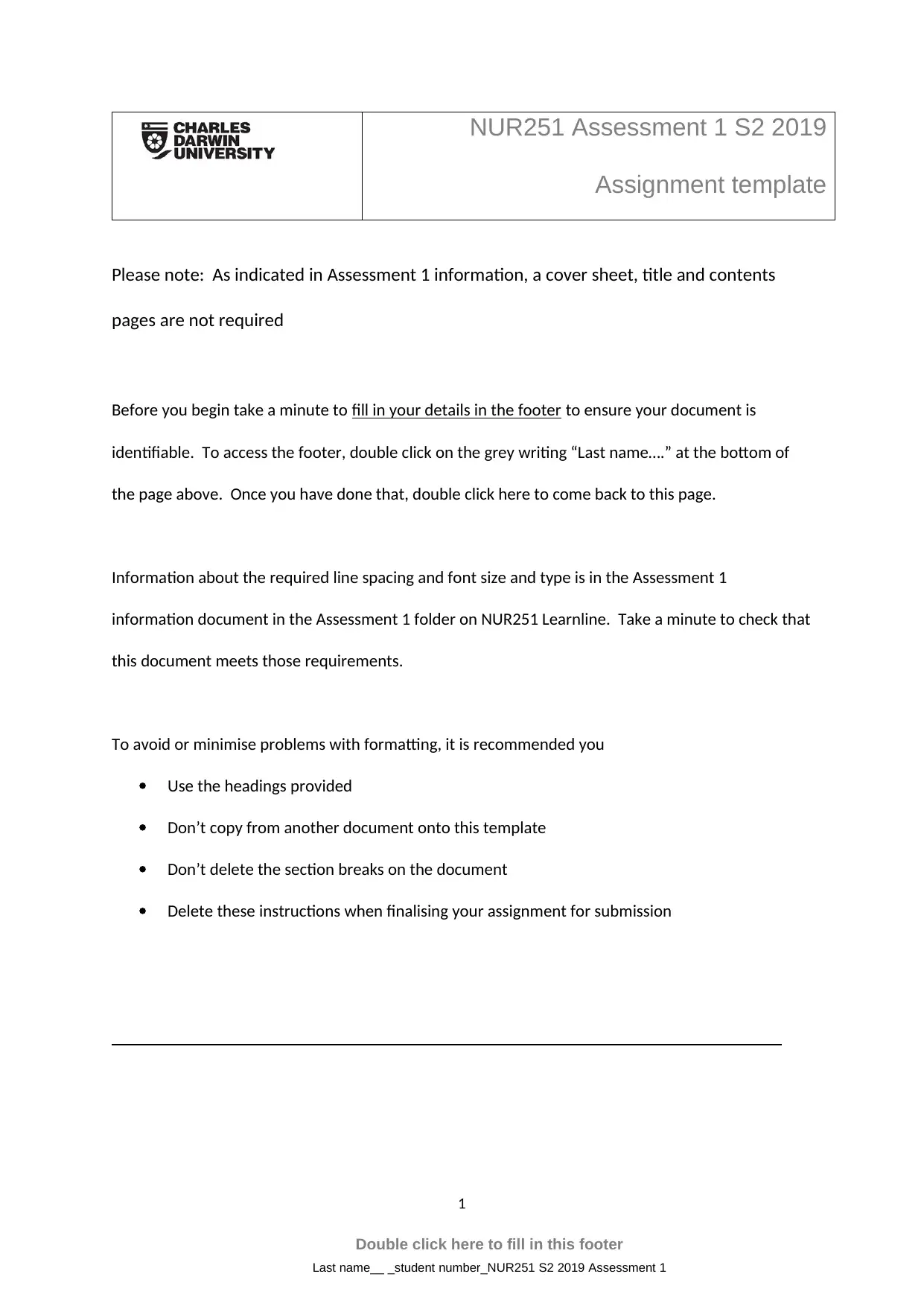
NUR251 Assessment 1 S2 2019
Assignment template
Please note: As indicated in Assessment 1 information, a cover sheet, title and contents
pages are not required
Before you begin take a minute to fill in your details in the footer to ensure your document is
identifiable. To access the footer, double click on the grey writing “Last name….” at the bottom of
the page above. Once you have done that, double click here to come back to this page.
Information about the required line spacing and font size and type is in the Assessment 1
information document in the Assessment 1 folder on NUR251 Learnline. Take a minute to check that
this document meets those requirements.
To avoid or minimise problems with formatting, it is recommended you
Use the headings provided
Don’t copy from another document onto this template
Don’t delete the section breaks on the document
Delete these instructions when finalising your assignment for submission
1
Double click here to fill in this footer
Last name__ _student number_NUR251 S2 2019 Assessment 1
Assignment template
Please note: As indicated in Assessment 1 information, a cover sheet, title and contents
pages are not required
Before you begin take a minute to fill in your details in the footer to ensure your document is
identifiable. To access the footer, double click on the grey writing “Last name….” at the bottom of
the page above. Once you have done that, double click here to come back to this page.
Information about the required line spacing and font size and type is in the Assessment 1
information document in the Assessment 1 folder on NUR251 Learnline. Take a minute to check that
this document meets those requirements.
To avoid or minimise problems with formatting, it is recommended you
Use the headings provided
Don’t copy from another document onto this template
Don’t delete the section breaks on the document
Delete these instructions when finalising your assignment for submission
1
Double click here to fill in this footer
Last name__ _student number_NUR251 S2 2019 Assessment 1
Secure Best Marks with AI Grader
Need help grading? Try our AI Grader for instant feedback on your assignments.
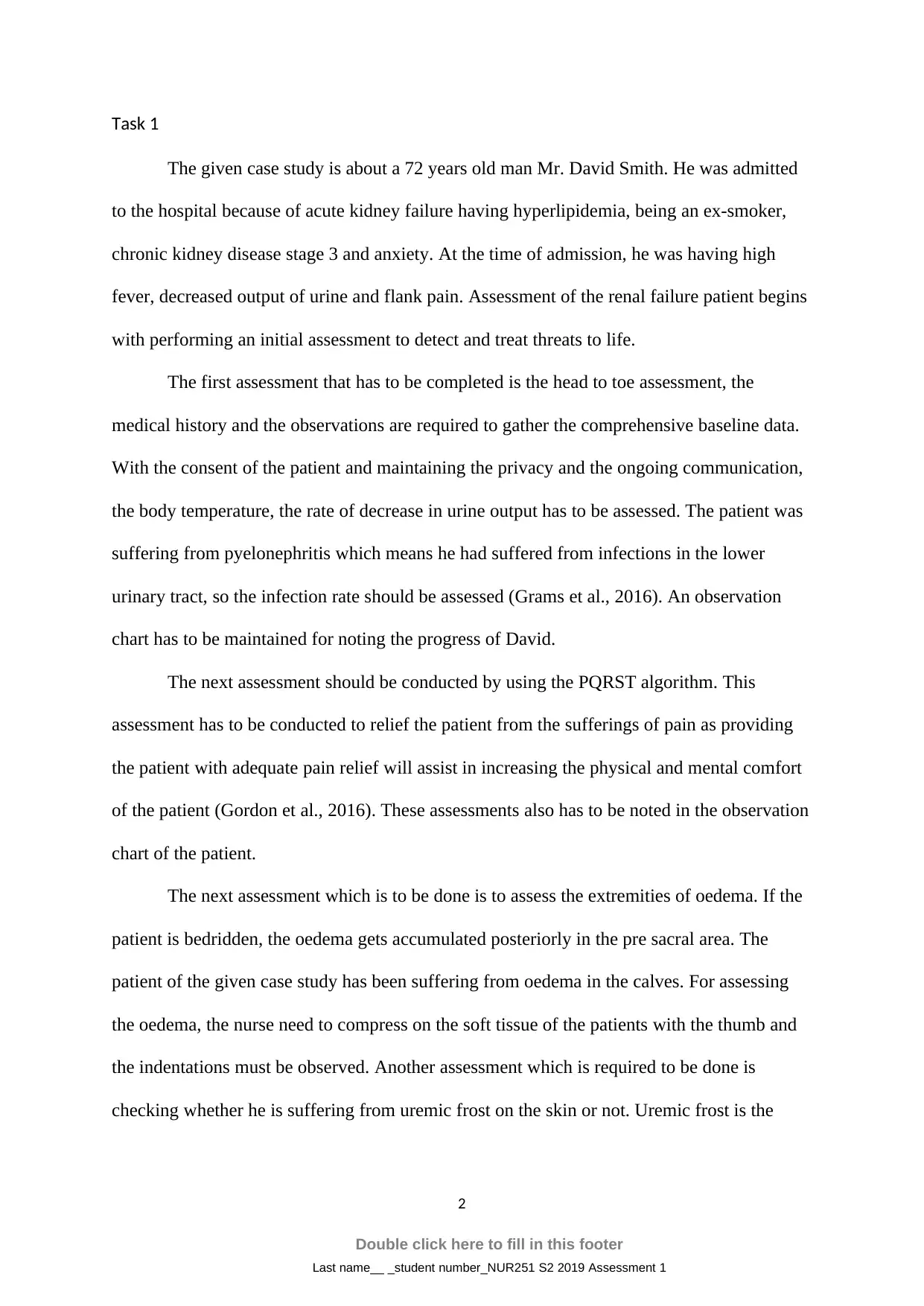
Task 1
The given case study is about a 72 years old man Mr. David Smith. He was admitted
to the hospital because of acute kidney failure having hyperlipidemia, being an ex-smoker,
chronic kidney disease stage 3 and anxiety. At the time of admission, he was having high
fever, decreased output of urine and flank pain. Assessment of the renal failure patient begins
with performing an initial assessment to detect and treat threats to life.
The first assessment that has to be completed is the head to toe assessment, the
medical history and the observations are required to gather the comprehensive baseline data.
With the consent of the patient and maintaining the privacy and the ongoing communication,
the body temperature, the rate of decrease in urine output has to be assessed. The patient was
suffering from pyelonephritis which means he had suffered from infections in the lower
urinary tract, so the infection rate should be assessed (Grams et al., 2016). An observation
chart has to be maintained for noting the progress of David.
The next assessment should be conducted by using the PQRST algorithm. This
assessment has to be conducted to relief the patient from the sufferings of pain as providing
the patient with adequate pain relief will assist in increasing the physical and mental comfort
of the patient (Gordon et al., 2016). These assessments also has to be noted in the observation
chart of the patient.
The next assessment which is to be done is to assess the extremities of oedema. If the
patient is bedridden, the oedema gets accumulated posteriorly in the pre sacral area. The
patient of the given case study has been suffering from oedema in the calves. For assessing
the oedema, the nurse need to compress on the soft tissue of the patients with the thumb and
the indentations must be observed. Another assessment which is required to be done is
checking whether he is suffering from uremic frost on the skin or not. Uremic frost is the
2
Double click here to fill in this footer
Last name__ _student number_NUR251 S2 2019 Assessment 1
The given case study is about a 72 years old man Mr. David Smith. He was admitted
to the hospital because of acute kidney failure having hyperlipidemia, being an ex-smoker,
chronic kidney disease stage 3 and anxiety. At the time of admission, he was having high
fever, decreased output of urine and flank pain. Assessment of the renal failure patient begins
with performing an initial assessment to detect and treat threats to life.
The first assessment that has to be completed is the head to toe assessment, the
medical history and the observations are required to gather the comprehensive baseline data.
With the consent of the patient and maintaining the privacy and the ongoing communication,
the body temperature, the rate of decrease in urine output has to be assessed. The patient was
suffering from pyelonephritis which means he had suffered from infections in the lower
urinary tract, so the infection rate should be assessed (Grams et al., 2016). An observation
chart has to be maintained for noting the progress of David.
The next assessment should be conducted by using the PQRST algorithm. This
assessment has to be conducted to relief the patient from the sufferings of pain as providing
the patient with adequate pain relief will assist in increasing the physical and mental comfort
of the patient (Gordon et al., 2016). These assessments also has to be noted in the observation
chart of the patient.
The next assessment which is to be done is to assess the extremities of oedema. If the
patient is bedridden, the oedema gets accumulated posteriorly in the pre sacral area. The
patient of the given case study has been suffering from oedema in the calves. For assessing
the oedema, the nurse need to compress on the soft tissue of the patients with the thumb and
the indentations must be observed. Another assessment which is required to be done is
checking whether he is suffering from uremic frost on the skin or not. Uremic frost is the
2
Double click here to fill in this footer
Last name__ _student number_NUR251 S2 2019 Assessment 1
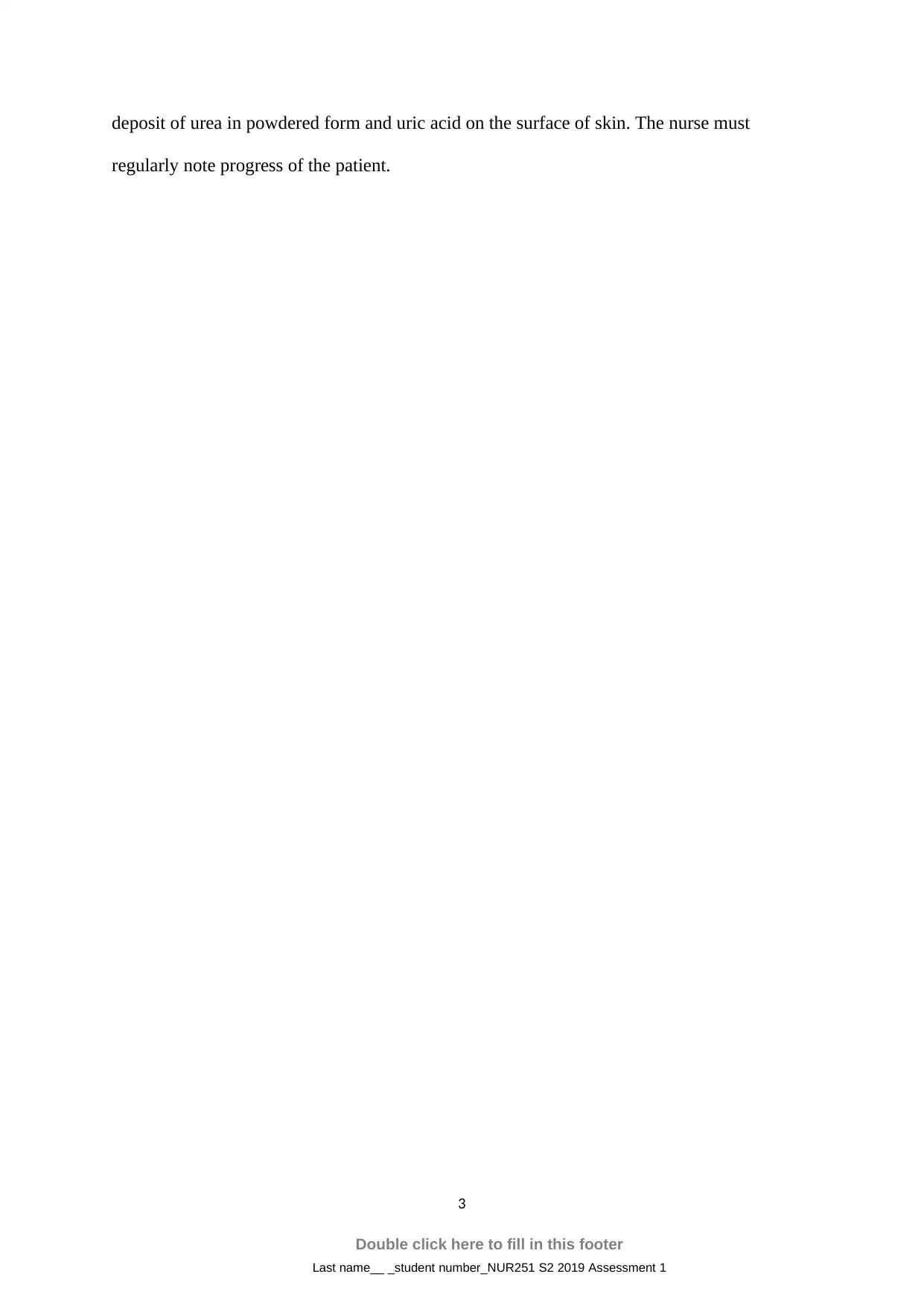
deposit of urea in powdered form and uric acid on the surface of skin. The nurse must
regularly note progress of the patient.
3
Double click here to fill in this footer
Last name__ _student number_NUR251 S2 2019 Assessment 1
regularly note progress of the patient.
3
Double click here to fill in this footer
Last name__ _student number_NUR251 S2 2019 Assessment 1
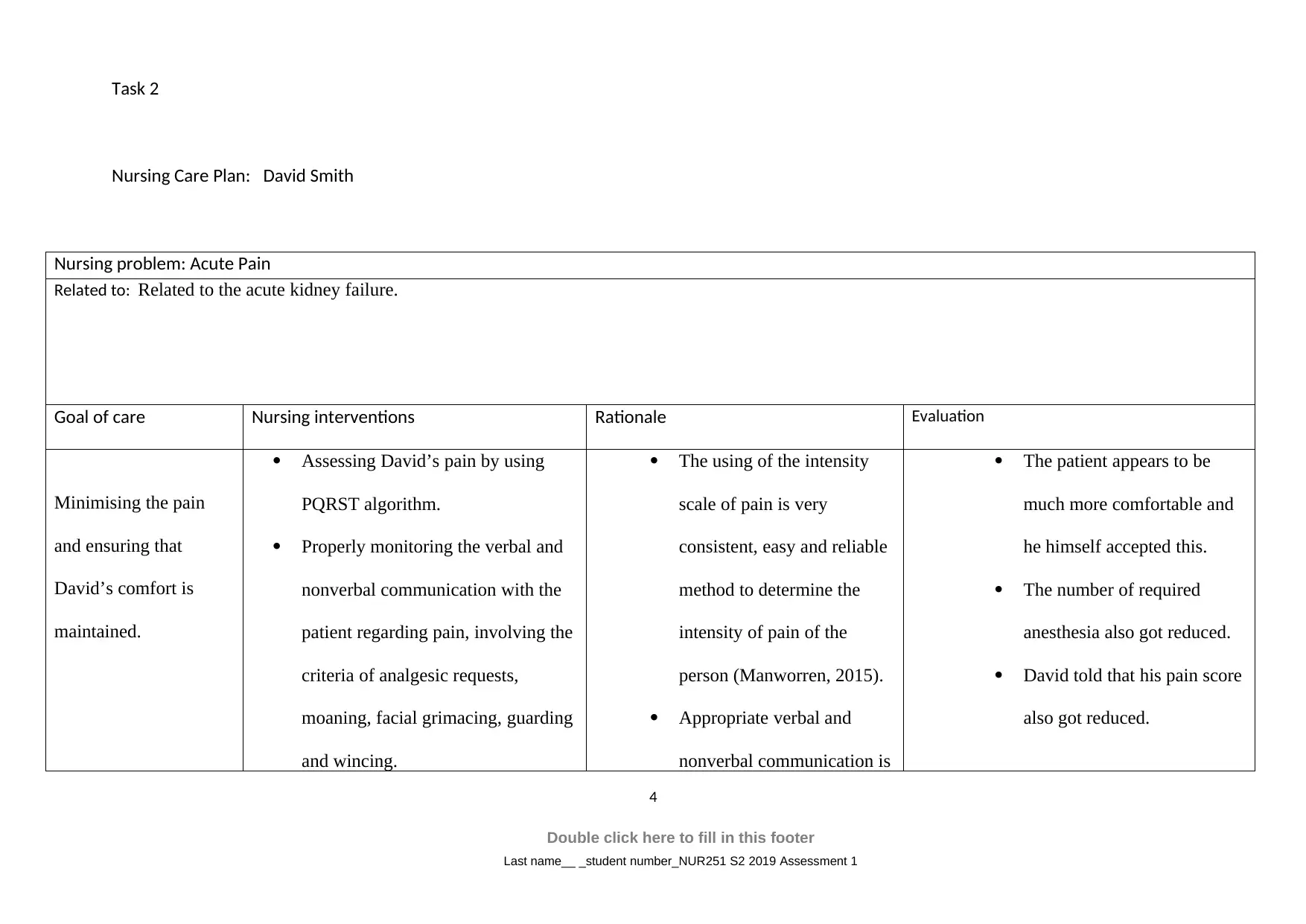
Task 2
Nursing Care Plan: David Smith
Nursing problem: Acute Pain
Related to: Related to the acute kidney failure.
Goal of care Nursing interventions Rationale Evaluation
Minimising the pain
and ensuring that
David’s comfort is
maintained.
Assessing David’s pain by using
PQRST algorithm.
Properly monitoring the verbal and
nonverbal communication with the
patient regarding pain, involving the
criteria of analgesic requests,
moaning, facial grimacing, guarding
and wincing.
The using of the intensity
scale of pain is very
consistent, easy and reliable
method to determine the
intensity of pain of the
person (Manworren, 2015).
Appropriate verbal and
nonverbal communication is
The patient appears to be
much more comfortable and
he himself accepted this.
The number of required
anesthesia also got reduced.
David told that his pain score
also got reduced.
4
Double click here to fill in this footer
Last name__ _student number_NUR251 S2 2019 Assessment 1
Nursing Care Plan: David Smith
Nursing problem: Acute Pain
Related to: Related to the acute kidney failure.
Goal of care Nursing interventions Rationale Evaluation
Minimising the pain
and ensuring that
David’s comfort is
maintained.
Assessing David’s pain by using
PQRST algorithm.
Properly monitoring the verbal and
nonverbal communication with the
patient regarding pain, involving the
criteria of analgesic requests,
moaning, facial grimacing, guarding
and wincing.
The using of the intensity
scale of pain is very
consistent, easy and reliable
method to determine the
intensity of pain of the
person (Manworren, 2015).
Appropriate verbal and
nonverbal communication is
The patient appears to be
much more comfortable and
he himself accepted this.
The number of required
anesthesia also got reduced.
David told that his pain score
also got reduced.
4
Double click here to fill in this footer
Last name__ _student number_NUR251 S2 2019 Assessment 1
Secure Best Marks with AI Grader
Need help grading? Try our AI Grader for instant feedback on your assignments.
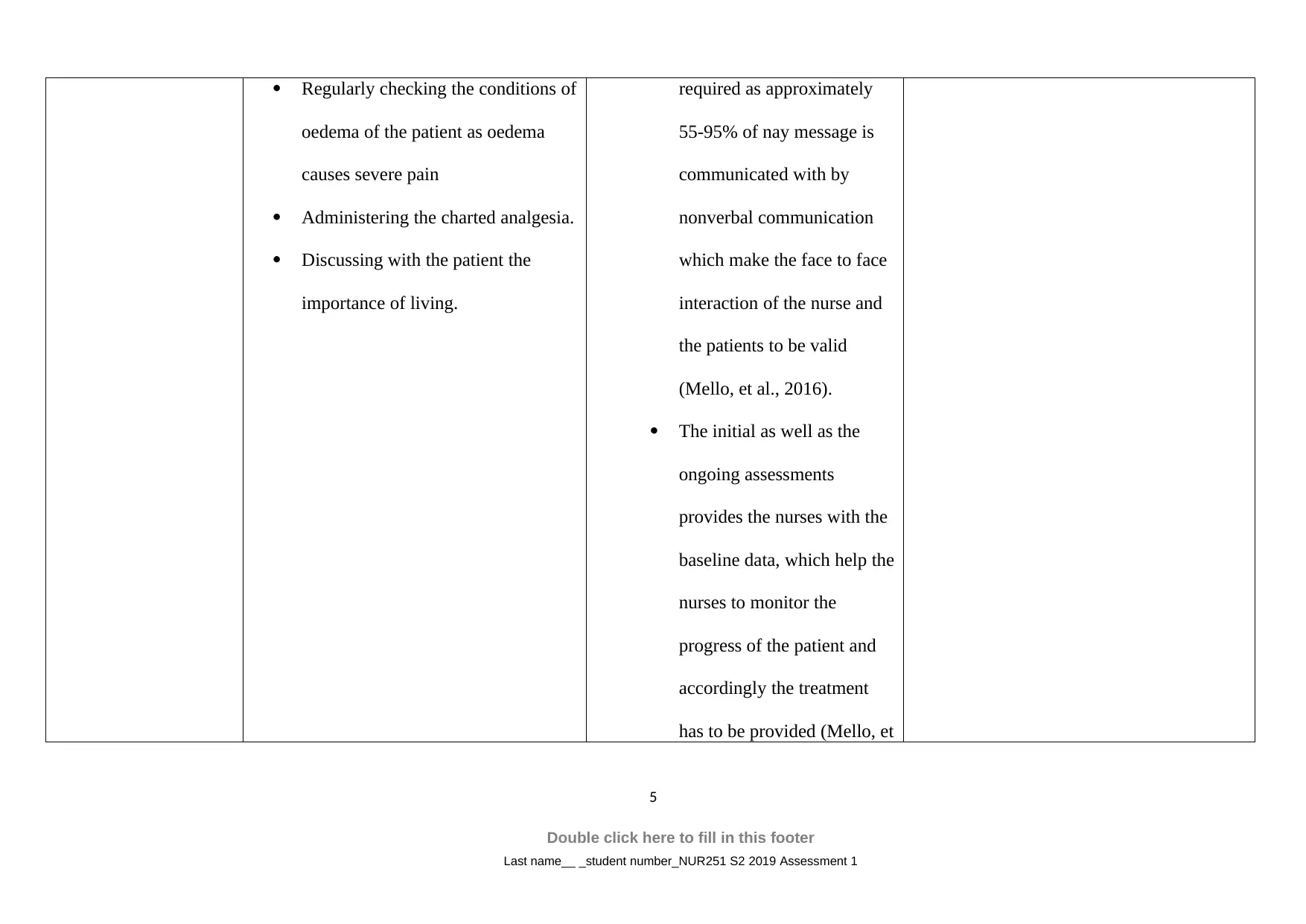
Regularly checking the conditions of
oedema of the patient as oedema
causes severe pain
Administering the charted analgesia.
Discussing with the patient the
importance of living.
required as approximately
55-95% of nay message is
communicated with by
nonverbal communication
which make the face to face
interaction of the nurse and
the patients to be valid
(Mello, et al., 2016).
The initial as well as the
ongoing assessments
provides the nurses with the
baseline data, which help the
nurses to monitor the
progress of the patient and
accordingly the treatment
has to be provided (Mello, et
5
Double click here to fill in this footer
Last name__ _student number_NUR251 S2 2019 Assessment 1
oedema of the patient as oedema
causes severe pain
Administering the charted analgesia.
Discussing with the patient the
importance of living.
required as approximately
55-95% of nay message is
communicated with by
nonverbal communication
which make the face to face
interaction of the nurse and
the patients to be valid
(Mello, et al., 2016).
The initial as well as the
ongoing assessments
provides the nurses with the
baseline data, which help the
nurses to monitor the
progress of the patient and
accordingly the treatment
has to be provided (Mello, et
5
Double click here to fill in this footer
Last name__ _student number_NUR251 S2 2019 Assessment 1
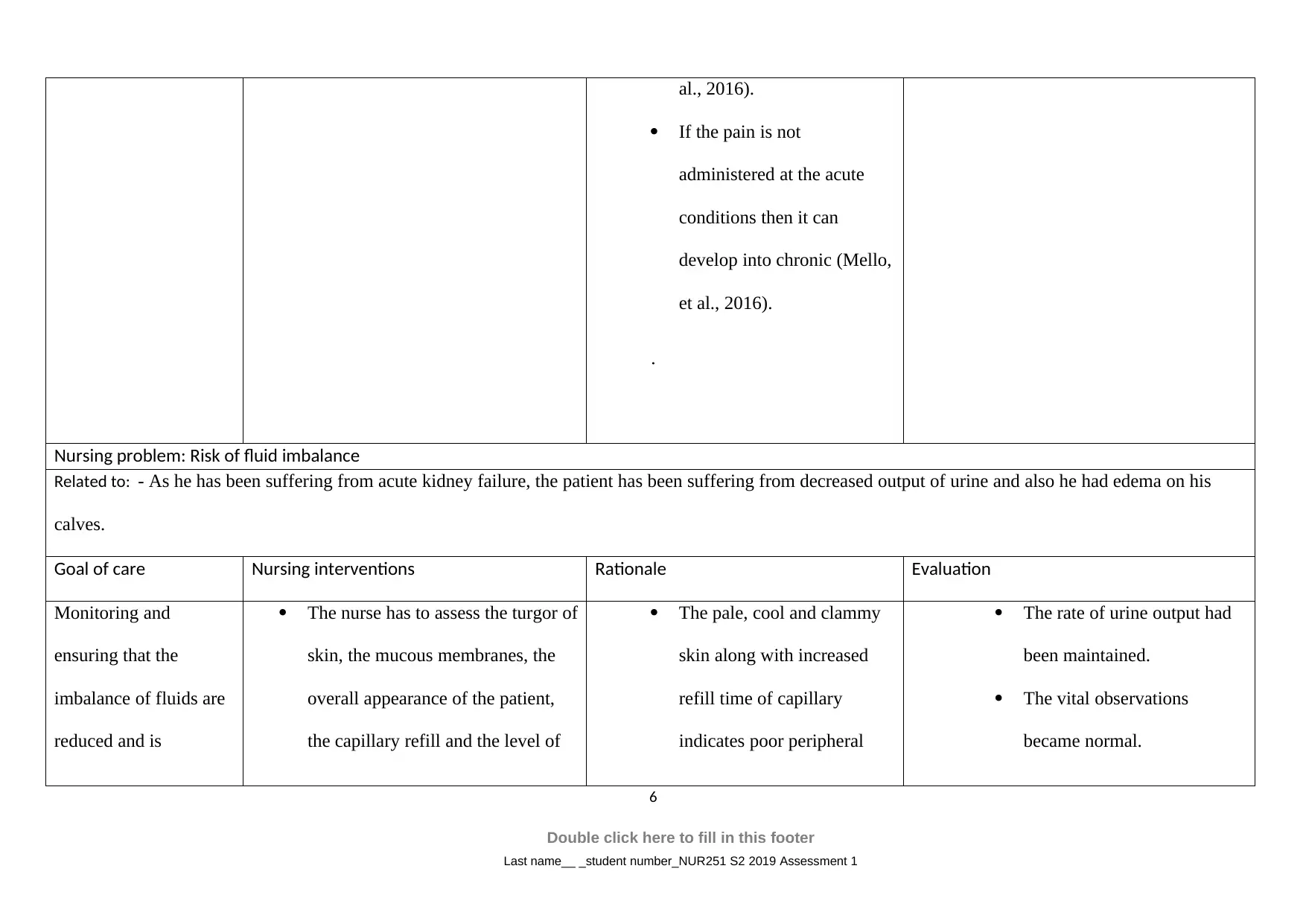
al., 2016).
If the pain is not
administered at the acute
conditions then it can
develop into chronic (Mello,
et al., 2016).
.
Nursing problem: Risk of fluid imbalance
Related to: - As he has been suffering from acute kidney failure, the patient has been suffering from decreased output of urine and also he had edema on his
calves.
Goal of care Nursing interventions Rationale Evaluation
Monitoring and
ensuring that the
imbalance of fluids are
reduced and is
The nurse has to assess the turgor of
skin, the mucous membranes, the
overall appearance of the patient,
the capillary refill and the level of
The pale, cool and clammy
skin along with increased
refill time of capillary
indicates poor peripheral
The rate of urine output had
been maintained.
The vital observations
became normal.
6
Double click here to fill in this footer
Last name__ _student number_NUR251 S2 2019 Assessment 1
If the pain is not
administered at the acute
conditions then it can
develop into chronic (Mello,
et al., 2016).
.
Nursing problem: Risk of fluid imbalance
Related to: - As he has been suffering from acute kidney failure, the patient has been suffering from decreased output of urine and also he had edema on his
calves.
Goal of care Nursing interventions Rationale Evaluation
Monitoring and
ensuring that the
imbalance of fluids are
reduced and is
The nurse has to assess the turgor of
skin, the mucous membranes, the
overall appearance of the patient,
the capillary refill and the level of
The pale, cool and clammy
skin along with increased
refill time of capillary
indicates poor peripheral
The rate of urine output had
been maintained.
The vital observations
became normal.
6
Double click here to fill in this footer
Last name__ _student number_NUR251 S2 2019 Assessment 1
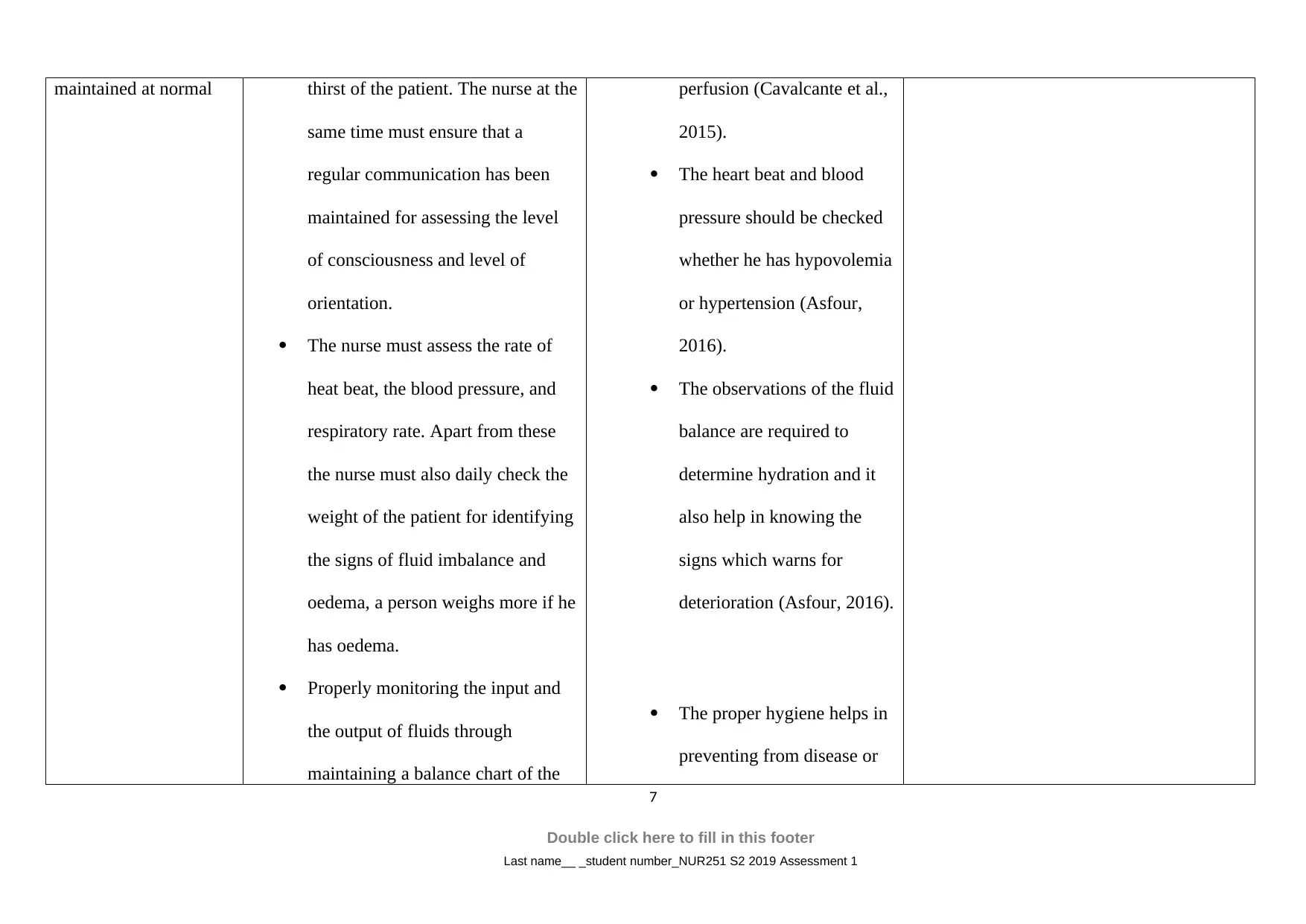
maintained at normal thirst of the patient. The nurse at the
same time must ensure that a
regular communication has been
maintained for assessing the level
of consciousness and level of
orientation.
The nurse must assess the rate of
heat beat, the blood pressure, and
respiratory rate. Apart from these
the nurse must also daily check the
weight of the patient for identifying
the signs of fluid imbalance and
oedema, a person weighs more if he
has oedema.
Properly monitoring the input and
the output of fluids through
maintaining a balance chart of the
perfusion (Cavalcante et al.,
2015).
The heart beat and blood
pressure should be checked
whether he has hypovolemia
or hypertension (Asfour,
2016).
The observations of the fluid
balance are required to
determine hydration and it
also help in knowing the
signs which warns for
deterioration (Asfour, 2016).
The proper hygiene helps in
preventing from disease or
7
Double click here to fill in this footer
Last name__ _student number_NUR251 S2 2019 Assessment 1
same time must ensure that a
regular communication has been
maintained for assessing the level
of consciousness and level of
orientation.
The nurse must assess the rate of
heat beat, the blood pressure, and
respiratory rate. Apart from these
the nurse must also daily check the
weight of the patient for identifying
the signs of fluid imbalance and
oedema, a person weighs more if he
has oedema.
Properly monitoring the input and
the output of fluids through
maintaining a balance chart of the
perfusion (Cavalcante et al.,
2015).
The heart beat and blood
pressure should be checked
whether he has hypovolemia
or hypertension (Asfour,
2016).
The observations of the fluid
balance are required to
determine hydration and it
also help in knowing the
signs which warns for
deterioration (Asfour, 2016).
The proper hygiene helps in
preventing from disease or
7
Double click here to fill in this footer
Last name__ _student number_NUR251 S2 2019 Assessment 1
Paraphrase This Document
Need a fresh take? Get an instant paraphrase of this document with our AI Paraphraser
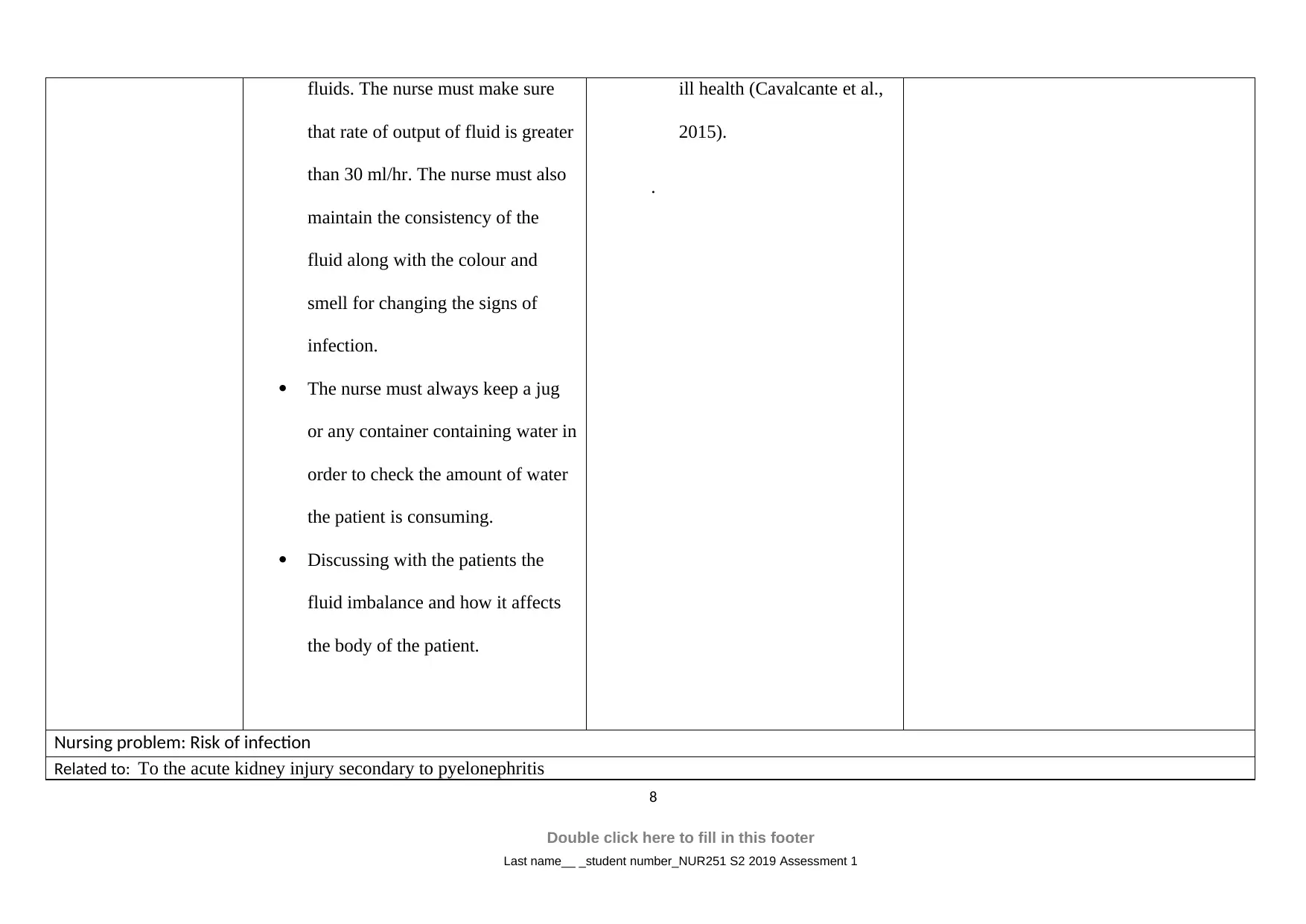
fluids. The nurse must make sure
that rate of output of fluid is greater
than 30 ml/hr. The nurse must also
maintain the consistency of the
fluid along with the colour and
smell for changing the signs of
infection.
The nurse must always keep a jug
or any container containing water in
order to check the amount of water
the patient is consuming.
Discussing with the patients the
fluid imbalance and how it affects
the body of the patient.
ill health (Cavalcante et al.,
2015).
.
Nursing problem: Risk of infection
Related to: To the acute kidney injury secondary to pyelonephritis
8
Double click here to fill in this footer
Last name__ _student number_NUR251 S2 2019 Assessment 1
that rate of output of fluid is greater
than 30 ml/hr. The nurse must also
maintain the consistency of the
fluid along with the colour and
smell for changing the signs of
infection.
The nurse must always keep a jug
or any container containing water in
order to check the amount of water
the patient is consuming.
Discussing with the patients the
fluid imbalance and how it affects
the body of the patient.
ill health (Cavalcante et al.,
2015).
.
Nursing problem: Risk of infection
Related to: To the acute kidney injury secondary to pyelonephritis
8
Double click here to fill in this footer
Last name__ _student number_NUR251 S2 2019 Assessment 1
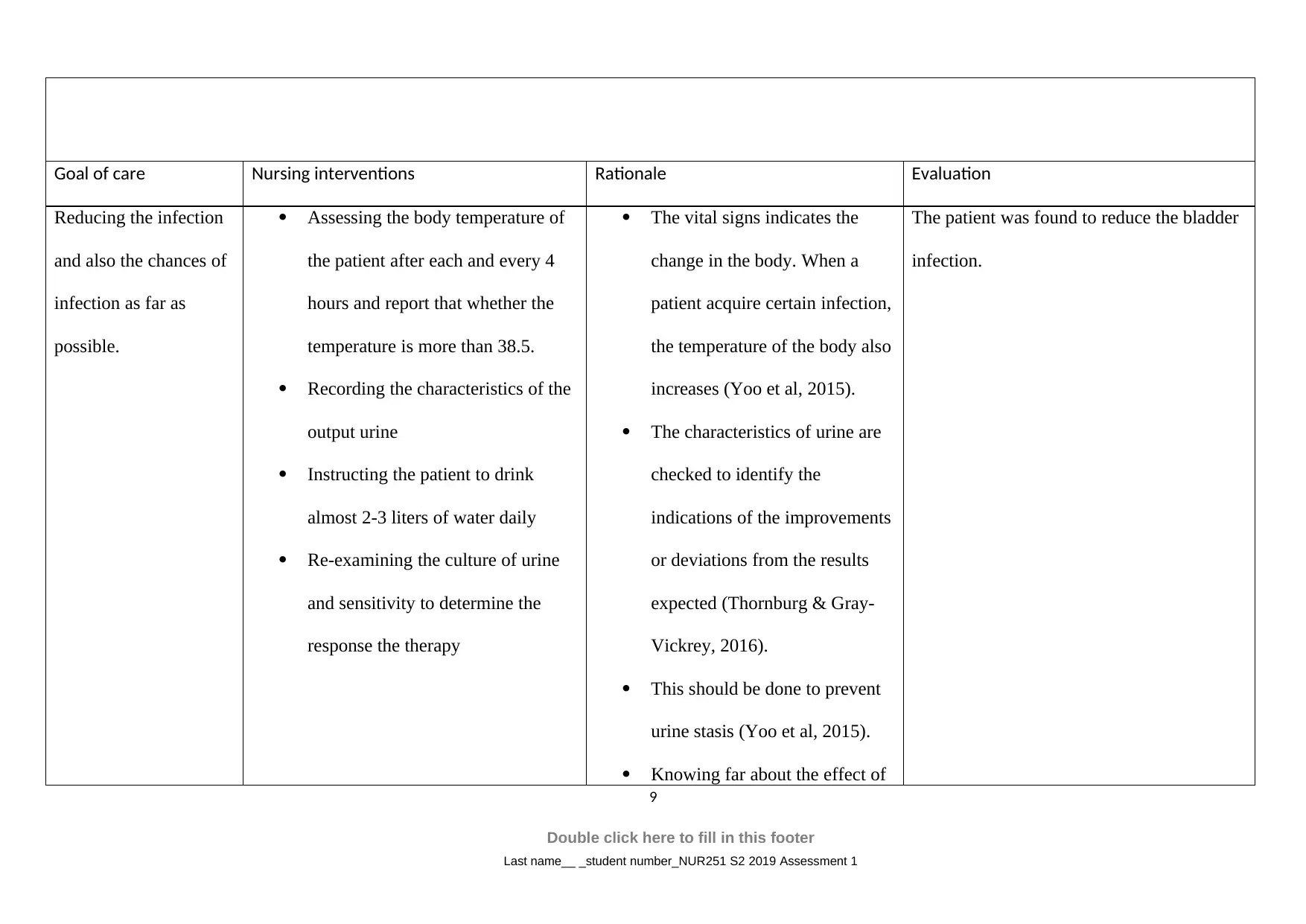
Goal of care Nursing interventions Rationale Evaluation
Reducing the infection
and also the chances of
infection as far as
possible.
Assessing the body temperature of
the patient after each and every 4
hours and report that whether the
temperature is more than 38.5.
Recording the characteristics of the
output urine
Instructing the patient to drink
almost 2-3 liters of water daily
Re-examining the culture of urine
and sensitivity to determine the
response the therapy
The vital signs indicates the
change in the body. When a
patient acquire certain infection,
the temperature of the body also
increases (Yoo et al, 2015).
The characteristics of urine are
checked to identify the
indications of the improvements
or deviations from the results
expected (Thornburg & Gray-
Vickrey, 2016).
This should be done to prevent
urine stasis (Yoo et al, 2015).
Knowing far about the effect of
The patient was found to reduce the bladder
infection.
9
Double click here to fill in this footer
Last name__ _student number_NUR251 S2 2019 Assessment 1
Reducing the infection
and also the chances of
infection as far as
possible.
Assessing the body temperature of
the patient after each and every 4
hours and report that whether the
temperature is more than 38.5.
Recording the characteristics of the
output urine
Instructing the patient to drink
almost 2-3 liters of water daily
Re-examining the culture of urine
and sensitivity to determine the
response the therapy
The vital signs indicates the
change in the body. When a
patient acquire certain infection,
the temperature of the body also
increases (Yoo et al, 2015).
The characteristics of urine are
checked to identify the
indications of the improvements
or deviations from the results
expected (Thornburg & Gray-
Vickrey, 2016).
This should be done to prevent
urine stasis (Yoo et al, 2015).
Knowing far about the effect of
The patient was found to reduce the bladder
infection.
9
Double click here to fill in this footer
Last name__ _student number_NUR251 S2 2019 Assessment 1

Instructing the patient to empty the
bladder totally
The nurse must provide perineal
care to the patient and maintain
them clean and dry. –
treatment on the circumstances
of the patient (Thornburg &
Gray-Vickrey, 2016). .
This is done to prevent the
distension of balder.
This should be done to prevent
the bacterial infection.
Nursing problem: Anxiety
Related to: Related to the high GCS value, acute pain and feeling of tired.
Goal of care Nursing interventions Rationale Evaluation
Reducing the risk of
anxiety by providing
Assessing the mental status of the
patient through observing his
The mental assessment is very
essential to judge about the
After the proper conversation David started
10
Double click here to fill in this footer
Last name__ _student number_NUR251 S2 2019 Assessment 1
bladder totally
The nurse must provide perineal
care to the patient and maintain
them clean and dry. –
treatment on the circumstances
of the patient (Thornburg &
Gray-Vickrey, 2016). .
This is done to prevent the
distension of balder.
This should be done to prevent
the bacterial infection.
Nursing problem: Anxiety
Related to: Related to the high GCS value, acute pain and feeling of tired.
Goal of care Nursing interventions Rationale Evaluation
Reducing the risk of
anxiety by providing
Assessing the mental status of the
patient through observing his
The mental assessment is very
essential to judge about the
After the proper conversation David started
10
Double click here to fill in this footer
Last name__ _student number_NUR251 S2 2019 Assessment 1
Secure Best Marks with AI Grader
Need help grading? Try our AI Grader for instant feedback on your assignments.
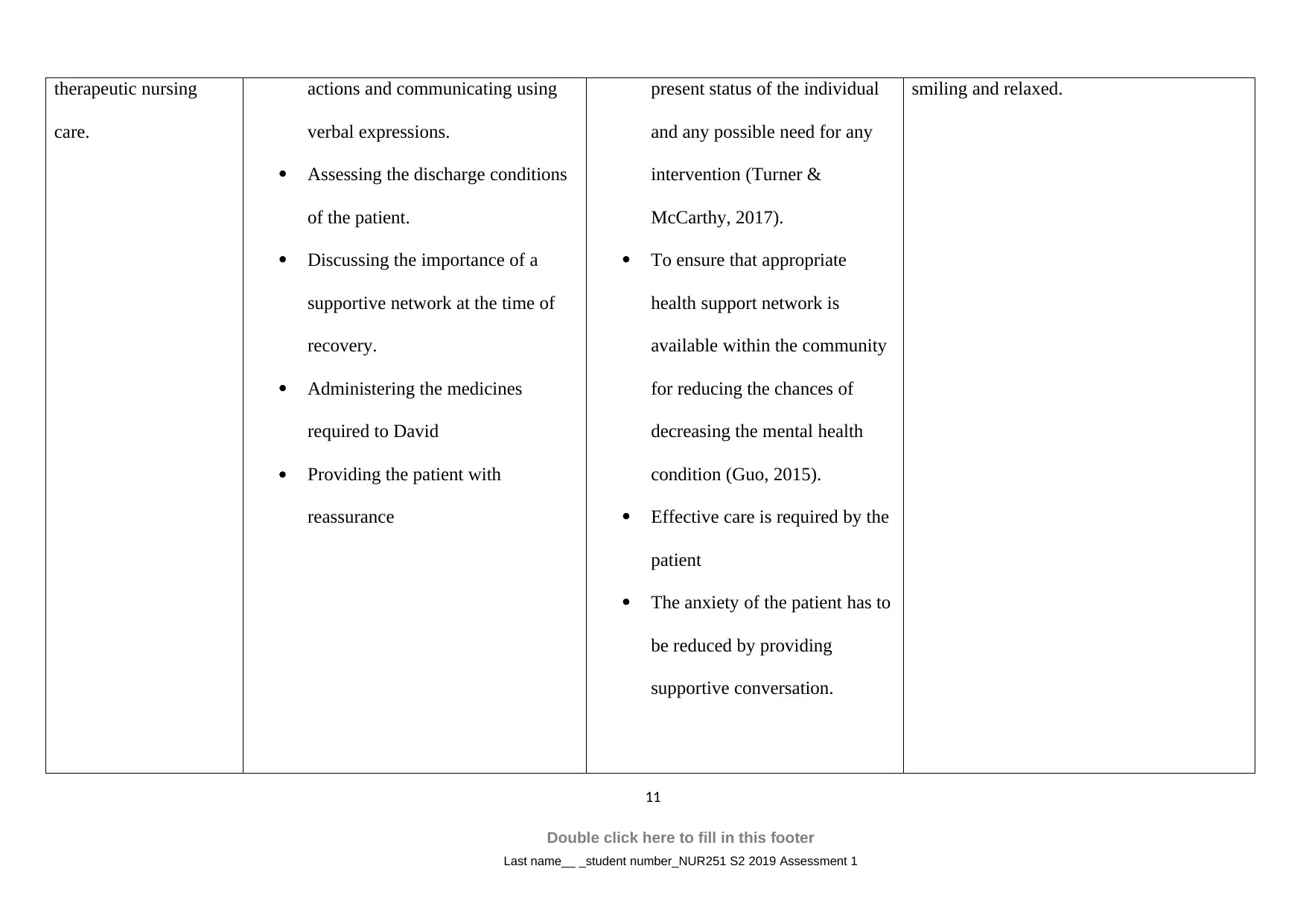
therapeutic nursing
care.
actions and communicating using
verbal expressions.
Assessing the discharge conditions
of the patient.
Discussing the importance of a
supportive network at the time of
recovery.
Administering the medicines
required to David
Providing the patient with
reassurance
present status of the individual
and any possible need for any
intervention (Turner &
McCarthy, 2017).
To ensure that appropriate
health support network is
available within the community
for reducing the chances of
decreasing the mental health
condition (Guo, 2015).
Effective care is required by the
patient
The anxiety of the patient has to
be reduced by providing
supportive conversation.
smiling and relaxed.
11
Double click here to fill in this footer
Last name__ _student number_NUR251 S2 2019 Assessment 1
care.
actions and communicating using
verbal expressions.
Assessing the discharge conditions
of the patient.
Discussing the importance of a
supportive network at the time of
recovery.
Administering the medicines
required to David
Providing the patient with
reassurance
present status of the individual
and any possible need for any
intervention (Turner &
McCarthy, 2017).
To ensure that appropriate
health support network is
available within the community
for reducing the chances of
decreasing the mental health
condition (Guo, 2015).
Effective care is required by the
patient
The anxiety of the patient has to
be reduced by providing
supportive conversation.
smiling and relaxed.
11
Double click here to fill in this footer
Last name__ _student number_NUR251 S2 2019 Assessment 1
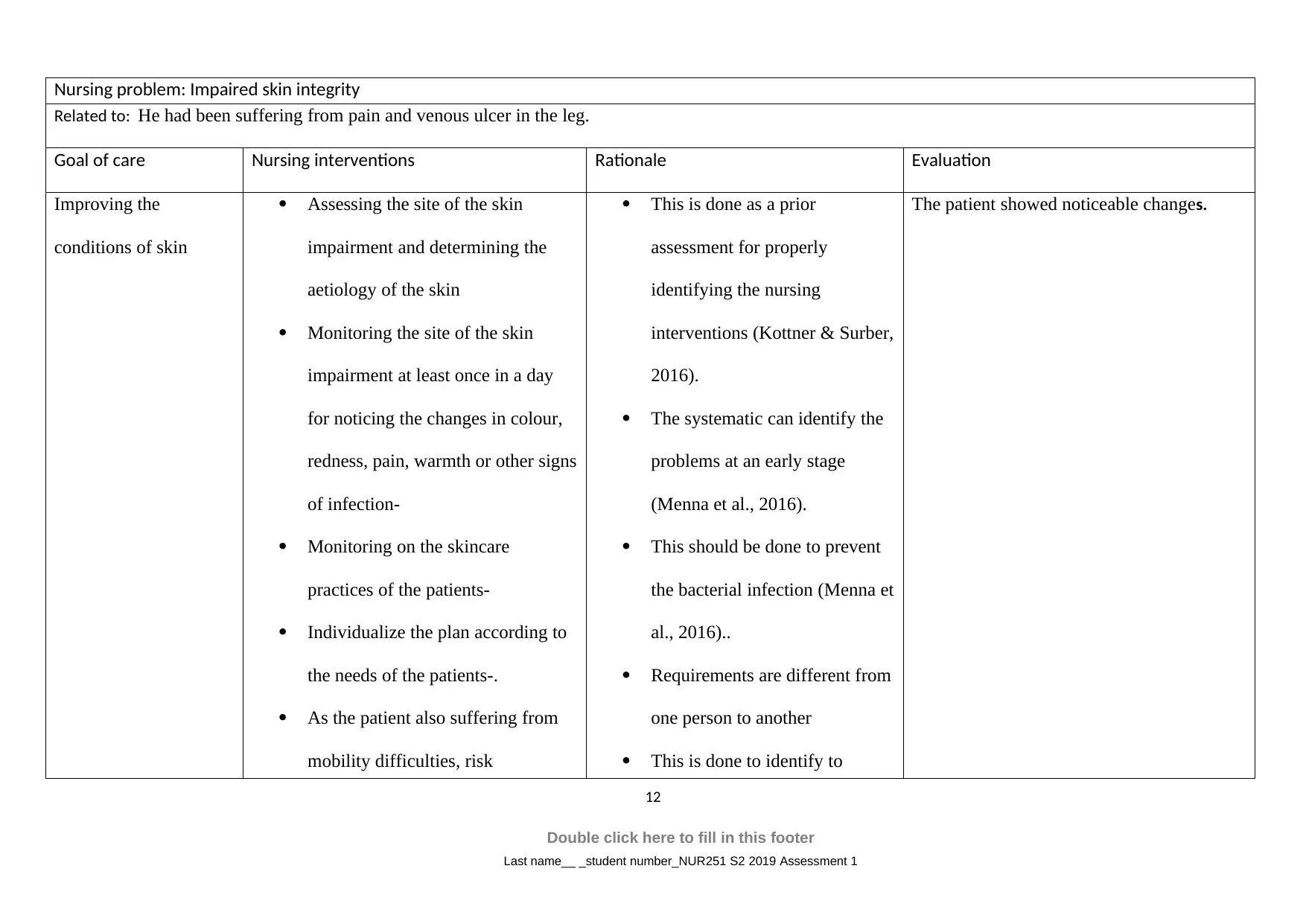
Nursing problem: Impaired skin integrity
Related to: He had been suffering from pain and venous ulcer in the leg.
Goal of care Nursing interventions Rationale Evaluation
Improving the
conditions of skin
Assessing the site of the skin
impairment and determining the
aetiology of the skin
Monitoring the site of the skin
impairment at least once in a day
for noticing the changes in colour,
redness, pain, warmth or other signs
of infection-
Monitoring on the skincare
practices of the patients-
Individualize the plan according to
the needs of the patients-.
As the patient also suffering from
mobility difficulties, risk
This is done as a prior
assessment for properly
identifying the nursing
interventions (Kottner & Surber,
2016).
The systematic can identify the
problems at an early stage
(Menna et al., 2016).
This should be done to prevent
the bacterial infection (Menna et
al., 2016)..
Requirements are different from
one person to another
This is done to identify to
The patient showed noticeable changes.
12
Double click here to fill in this footer
Last name__ _student number_NUR251 S2 2019 Assessment 1
Related to: He had been suffering from pain and venous ulcer in the leg.
Goal of care Nursing interventions Rationale Evaluation
Improving the
conditions of skin
Assessing the site of the skin
impairment and determining the
aetiology of the skin
Monitoring the site of the skin
impairment at least once in a day
for noticing the changes in colour,
redness, pain, warmth or other signs
of infection-
Monitoring on the skincare
practices of the patients-
Individualize the plan according to
the needs of the patients-.
As the patient also suffering from
mobility difficulties, risk
This is done as a prior
assessment for properly
identifying the nursing
interventions (Kottner & Surber,
2016).
The systematic can identify the
problems at an early stage
(Menna et al., 2016).
This should be done to prevent
the bacterial infection (Menna et
al., 2016)..
Requirements are different from
one person to another
This is done to identify to
The patient showed noticeable changes.
12
Double click here to fill in this footer
Last name__ _student number_NUR251 S2 2019 Assessment 1
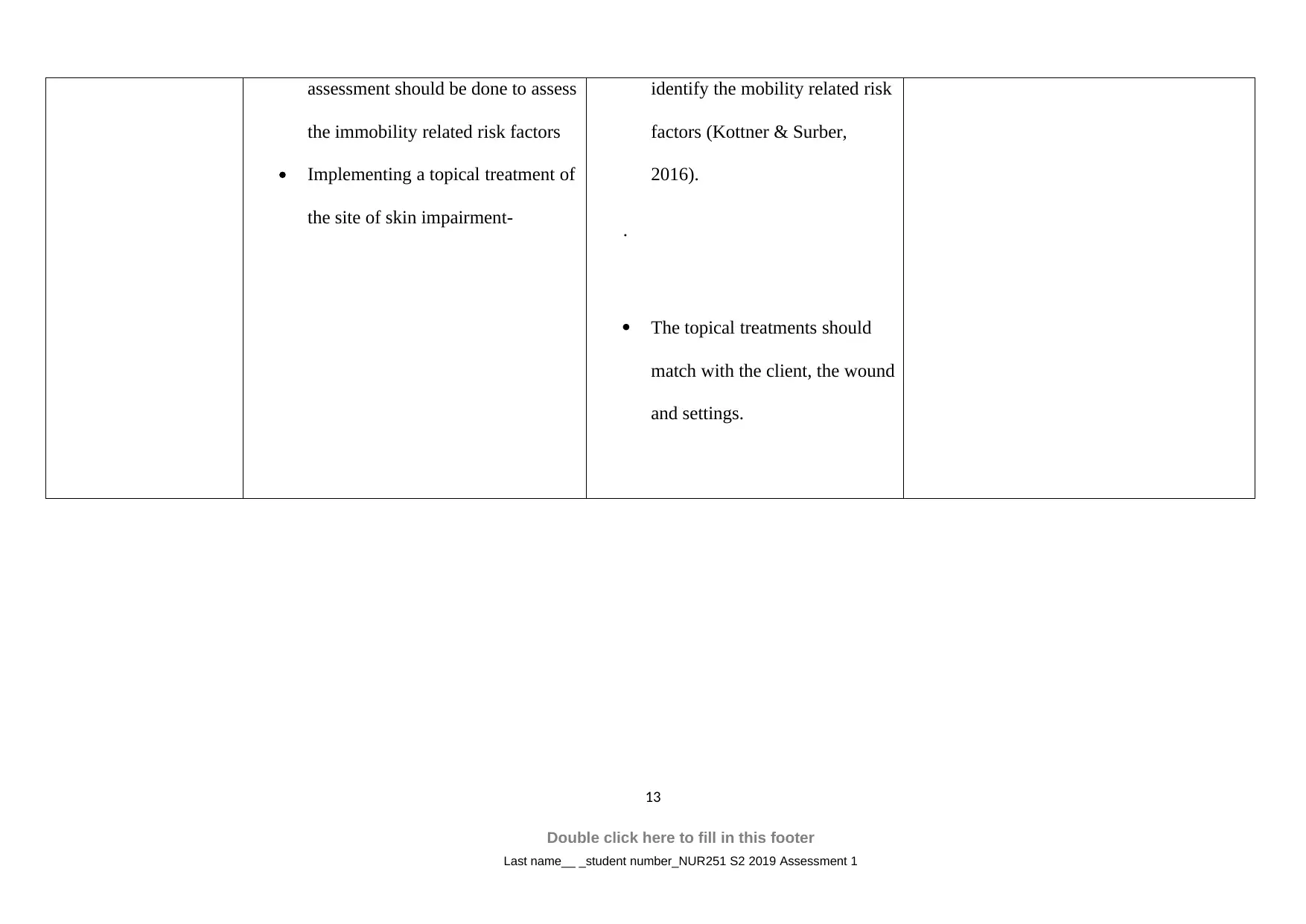
assessment should be done to assess
the immobility related risk factors
Implementing a topical treatment of
the site of skin impairment-
identify the mobility related risk
factors (Kottner & Surber,
2016).
.
The topical treatments should
match with the client, the wound
and settings.
13
Double click here to fill in this footer
Last name__ _student number_NUR251 S2 2019 Assessment 1
the immobility related risk factors
Implementing a topical treatment of
the site of skin impairment-
identify the mobility related risk
factors (Kottner & Surber,
2016).
.
The topical treatments should
match with the client, the wound
and settings.
13
Double click here to fill in this footer
Last name__ _student number_NUR251 S2 2019 Assessment 1
Paraphrase This Document
Need a fresh take? Get an instant paraphrase of this document with our AI Paraphraser
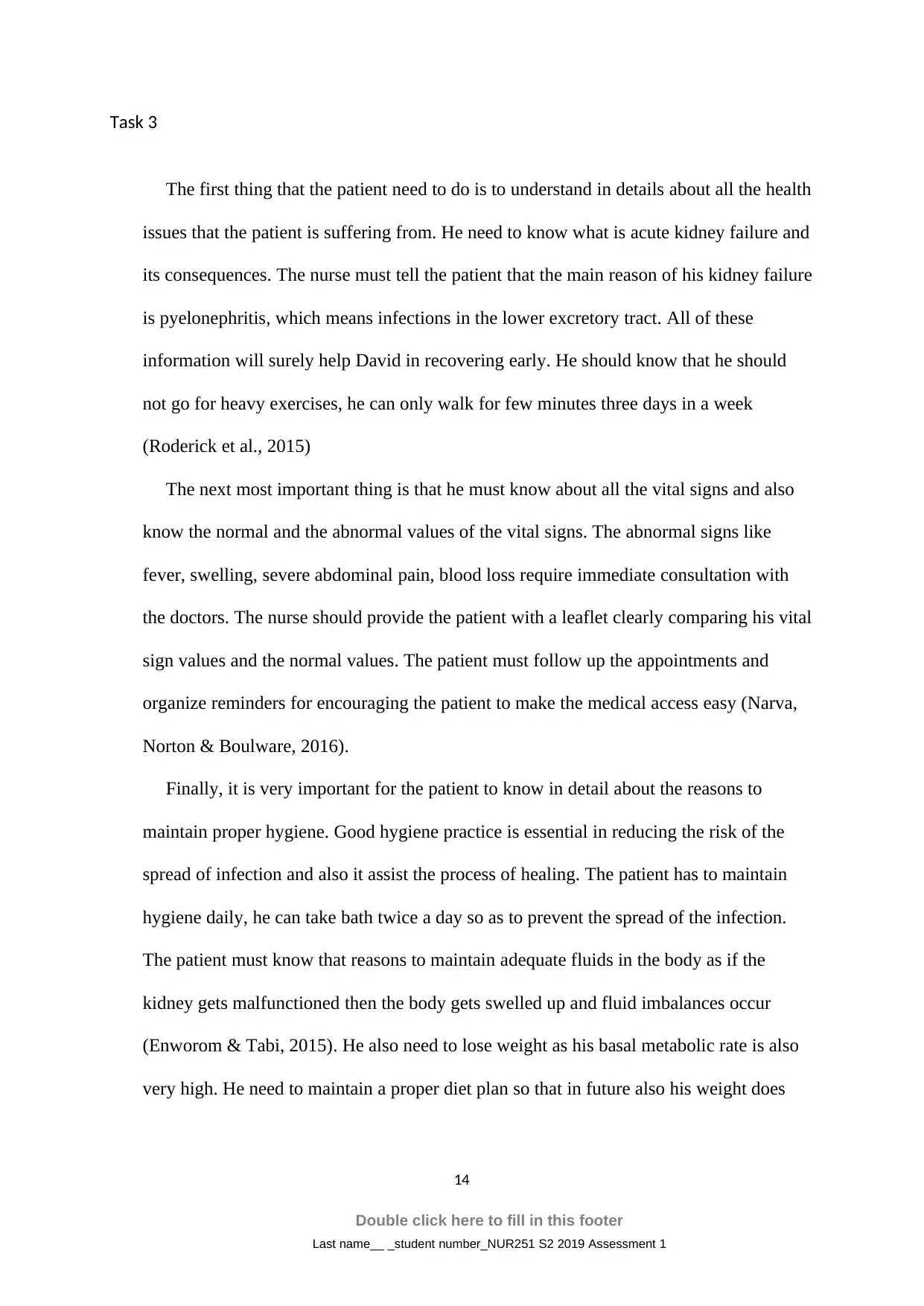
Task 3
The first thing that the patient need to do is to understand in details about all the health
issues that the patient is suffering from. He need to know what is acute kidney failure and
its consequences. The nurse must tell the patient that the main reason of his kidney failure
is pyelonephritis, which means infections in the lower excretory tract. All of these
information will surely help David in recovering early. He should know that he should
not go for heavy exercises, he can only walk for few minutes three days in a week
(Roderick et al., 2015)
The next most important thing is that he must know about all the vital signs and also
know the normal and the abnormal values of the vital signs. The abnormal signs like
fever, swelling, severe abdominal pain, blood loss require immediate consultation with
the doctors. The nurse should provide the patient with a leaflet clearly comparing his vital
sign values and the normal values. The patient must follow up the appointments and
organize reminders for encouraging the patient to make the medical access easy (Narva,
Norton & Boulware, 2016).
Finally, it is very important for the patient to know in detail about the reasons to
maintain proper hygiene. Good hygiene practice is essential in reducing the risk of the
spread of infection and also it assist the process of healing. The patient has to maintain
hygiene daily, he can take bath twice a day so as to prevent the spread of the infection.
The patient must know that reasons to maintain adequate fluids in the body as if the
kidney gets malfunctioned then the body gets swelled up and fluid imbalances occur
(Enworom & Tabi, 2015). He also need to lose weight as his basal metabolic rate is also
very high. He need to maintain a proper diet plan so that in future also his weight does
14
Double click here to fill in this footer
Last name__ _student number_NUR251 S2 2019 Assessment 1
The first thing that the patient need to do is to understand in details about all the health
issues that the patient is suffering from. He need to know what is acute kidney failure and
its consequences. The nurse must tell the patient that the main reason of his kidney failure
is pyelonephritis, which means infections in the lower excretory tract. All of these
information will surely help David in recovering early. He should know that he should
not go for heavy exercises, he can only walk for few minutes three days in a week
(Roderick et al., 2015)
The next most important thing is that he must know about all the vital signs and also
know the normal and the abnormal values of the vital signs. The abnormal signs like
fever, swelling, severe abdominal pain, blood loss require immediate consultation with
the doctors. The nurse should provide the patient with a leaflet clearly comparing his vital
sign values and the normal values. The patient must follow up the appointments and
organize reminders for encouraging the patient to make the medical access easy (Narva,
Norton & Boulware, 2016).
Finally, it is very important for the patient to know in detail about the reasons to
maintain proper hygiene. Good hygiene practice is essential in reducing the risk of the
spread of infection and also it assist the process of healing. The patient has to maintain
hygiene daily, he can take bath twice a day so as to prevent the spread of the infection.
The patient must know that reasons to maintain adequate fluids in the body as if the
kidney gets malfunctioned then the body gets swelled up and fluid imbalances occur
(Enworom & Tabi, 2015). He also need to lose weight as his basal metabolic rate is also
very high. He need to maintain a proper diet plan so that in future also his weight does
14
Double click here to fill in this footer
Last name__ _student number_NUR251 S2 2019 Assessment 1
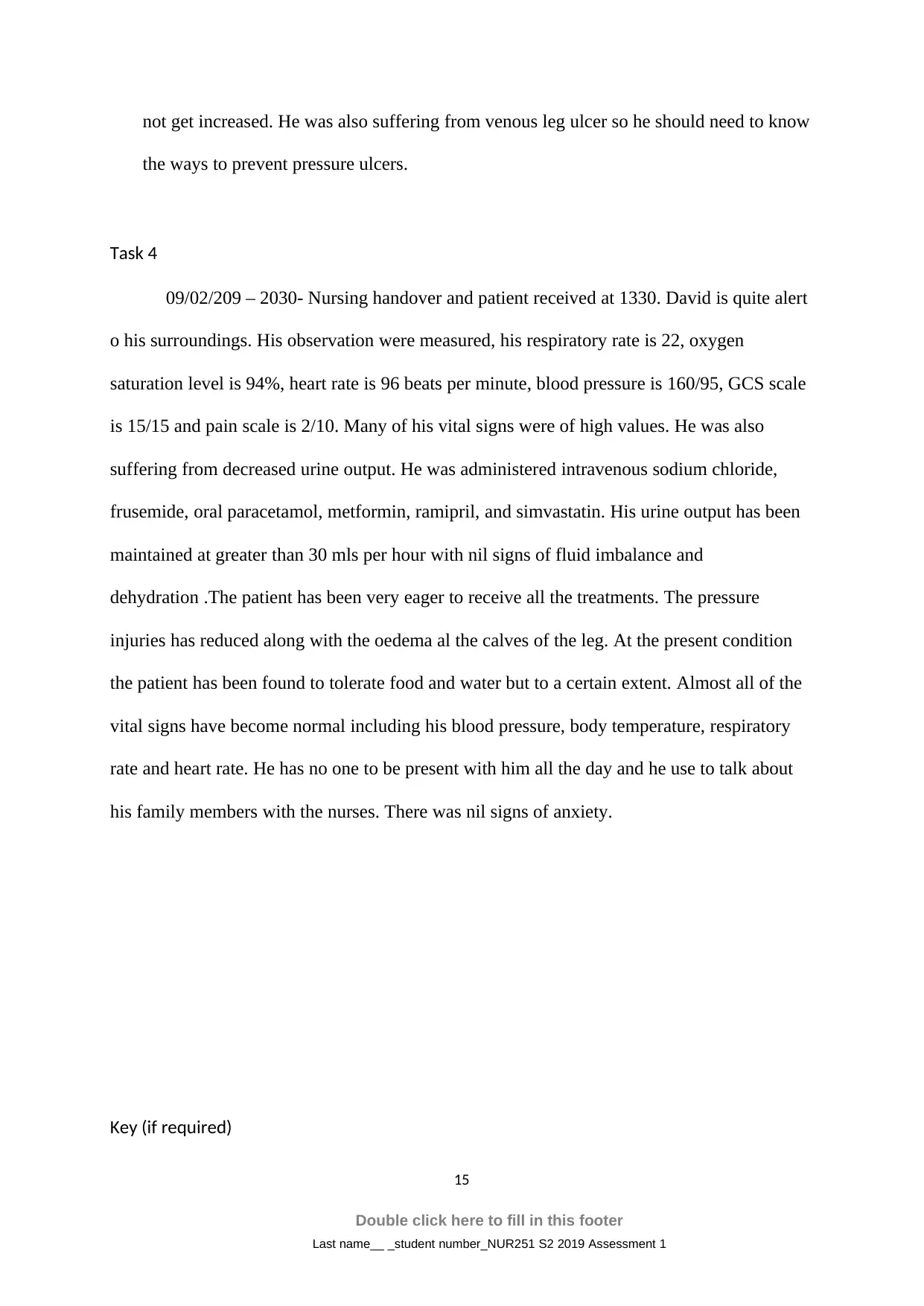
not get increased. He was also suffering from venous leg ulcer so he should need to know
the ways to prevent pressure ulcers.
Task 4
09/02/209 – 2030- Nursing handover and patient received at 1330. David is quite alert
o his surroundings. His observation were measured, his respiratory rate is 22, oxygen
saturation level is 94%, heart rate is 96 beats per minute, blood pressure is 160/95, GCS scale
is 15/15 and pain scale is 2/10. Many of his vital signs were of high values. He was also
suffering from decreased urine output. He was administered intravenous sodium chloride,
frusemide, oral paracetamol, metformin, ramipril, and simvastatin. His urine output has been
maintained at greater than 30 mls per hour with nil signs of fluid imbalance and
dehydration .The patient has been very eager to receive all the treatments. The pressure
injuries has reduced along with the oedema al the calves of the leg. At the present condition
the patient has been found to tolerate food and water but to a certain extent. Almost all of the
vital signs have become normal including his blood pressure, body temperature, respiratory
rate and heart rate. He has no one to be present with him all the day and he use to talk about
his family members with the nurses. There was nil signs of anxiety.
Key (if required)
15
Double click here to fill in this footer
Last name__ _student number_NUR251 S2 2019 Assessment 1
the ways to prevent pressure ulcers.
Task 4
09/02/209 – 2030- Nursing handover and patient received at 1330. David is quite alert
o his surroundings. His observation were measured, his respiratory rate is 22, oxygen
saturation level is 94%, heart rate is 96 beats per minute, blood pressure is 160/95, GCS scale
is 15/15 and pain scale is 2/10. Many of his vital signs were of high values. He was also
suffering from decreased urine output. He was administered intravenous sodium chloride,
frusemide, oral paracetamol, metformin, ramipril, and simvastatin. His urine output has been
maintained at greater than 30 mls per hour with nil signs of fluid imbalance and
dehydration .The patient has been very eager to receive all the treatments. The pressure
injuries has reduced along with the oedema al the calves of the leg. At the present condition
the patient has been found to tolerate food and water but to a certain extent. Almost all of the
vital signs have become normal including his blood pressure, body temperature, respiratory
rate and heart rate. He has no one to be present with him all the day and he use to talk about
his family members with the nurses. There was nil signs of anxiety.
Key (if required)
15
Double click here to fill in this footer
Last name__ _student number_NUR251 S2 2019 Assessment 1
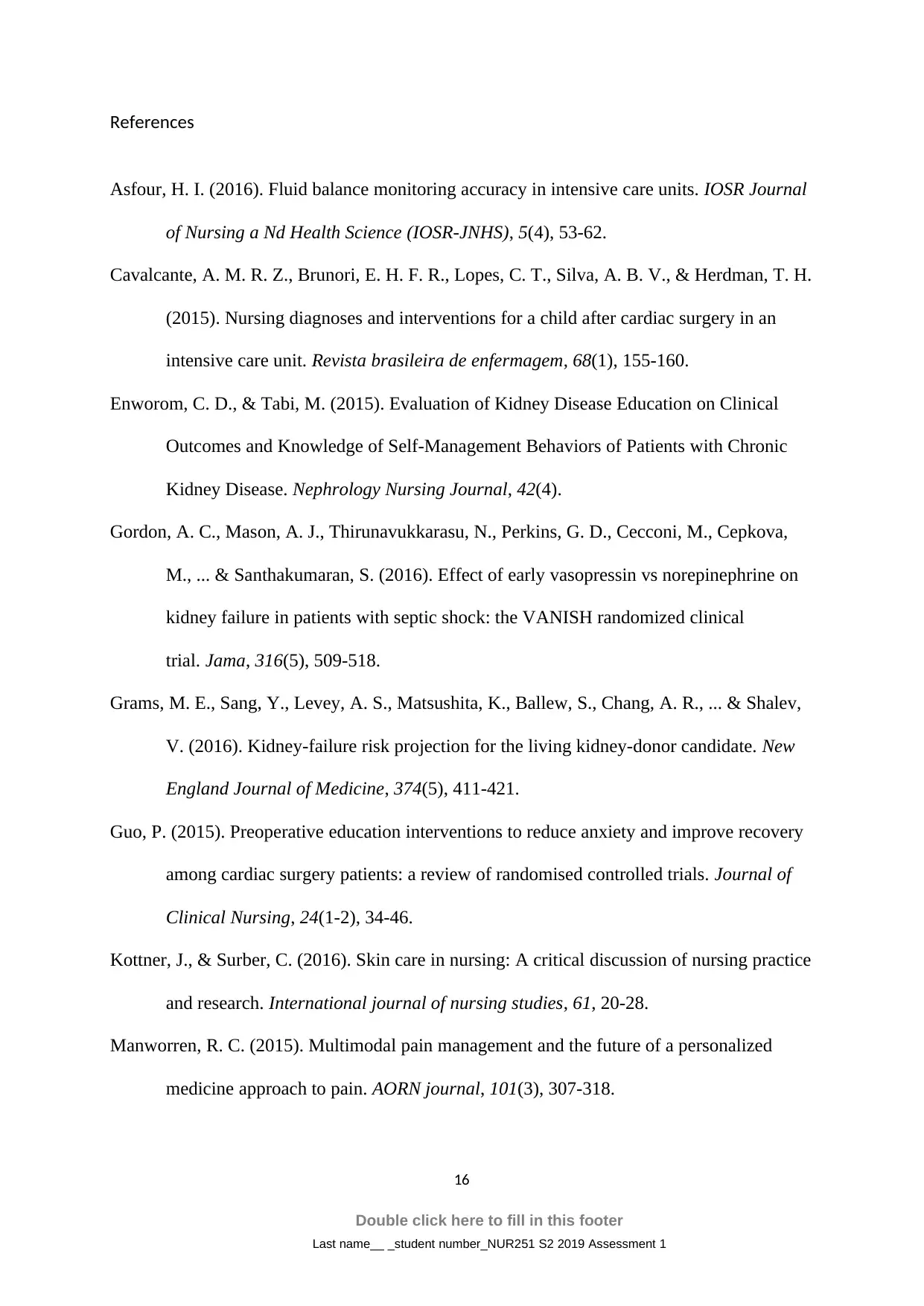
References
Asfour, H. I. (2016). Fluid balance monitoring accuracy in intensive care units. IOSR Journal
of Nursing a Nd Health Science (IOSR-JNHS), 5(4), 53-62.
Cavalcante, A. M. R. Z., Brunori, E. H. F. R., Lopes, C. T., Silva, A. B. V., & Herdman, T. H.
(2015). Nursing diagnoses and interventions for a child after cardiac surgery in an
intensive care unit. Revista brasileira de enfermagem, 68(1), 155-160.
Enworom, C. D., & Tabi, M. (2015). Evaluation of Kidney Disease Education on Clinical
Outcomes and Knowledge of Self-Management Behaviors of Patients with Chronic
Kidney Disease. Nephrology Nursing Journal, 42(4).
Gordon, A. C., Mason, A. J., Thirunavukkarasu, N., Perkins, G. D., Cecconi, M., Cepkova,
M., ... & Santhakumaran, S. (2016). Effect of early vasopressin vs norepinephrine on
kidney failure in patients with septic shock: the VANISH randomized clinical
trial. Jama, 316(5), 509-518.
Grams, M. E., Sang, Y., Levey, A. S., Matsushita, K., Ballew, S., Chang, A. R., ... & Shalev,
V. (2016). Kidney-failure risk projection for the living kidney-donor candidate. New
England Journal of Medicine, 374(5), 411-421.
Guo, P. (2015). Preoperative education interventions to reduce anxiety and improve recovery
among cardiac surgery patients: a review of randomised controlled trials. Journal of
Clinical Nursing, 24(1-2), 34-46.
Kottner, J., & Surber, C. (2016). Skin care in nursing: A critical discussion of nursing practice
and research. International journal of nursing studies, 61, 20-28.
Manworren, R. C. (2015). Multimodal pain management and the future of a personalized
medicine approach to pain. AORN journal, 101(3), 307-318.
16
Double click here to fill in this footer
Last name__ _student number_NUR251 S2 2019 Assessment 1
Asfour, H. I. (2016). Fluid balance monitoring accuracy in intensive care units. IOSR Journal
of Nursing a Nd Health Science (IOSR-JNHS), 5(4), 53-62.
Cavalcante, A. M. R. Z., Brunori, E. H. F. R., Lopes, C. T., Silva, A. B. V., & Herdman, T. H.
(2015). Nursing diagnoses and interventions for a child after cardiac surgery in an
intensive care unit. Revista brasileira de enfermagem, 68(1), 155-160.
Enworom, C. D., & Tabi, M. (2015). Evaluation of Kidney Disease Education on Clinical
Outcomes and Knowledge of Self-Management Behaviors of Patients with Chronic
Kidney Disease. Nephrology Nursing Journal, 42(4).
Gordon, A. C., Mason, A. J., Thirunavukkarasu, N., Perkins, G. D., Cecconi, M., Cepkova,
M., ... & Santhakumaran, S. (2016). Effect of early vasopressin vs norepinephrine on
kidney failure in patients with septic shock: the VANISH randomized clinical
trial. Jama, 316(5), 509-518.
Grams, M. E., Sang, Y., Levey, A. S., Matsushita, K., Ballew, S., Chang, A. R., ... & Shalev,
V. (2016). Kidney-failure risk projection for the living kidney-donor candidate. New
England Journal of Medicine, 374(5), 411-421.
Guo, P. (2015). Preoperative education interventions to reduce anxiety and improve recovery
among cardiac surgery patients: a review of randomised controlled trials. Journal of
Clinical Nursing, 24(1-2), 34-46.
Kottner, J., & Surber, C. (2016). Skin care in nursing: A critical discussion of nursing practice
and research. International journal of nursing studies, 61, 20-28.
Manworren, R. C. (2015). Multimodal pain management and the future of a personalized
medicine approach to pain. AORN journal, 101(3), 307-318.
16
Double click here to fill in this footer
Last name__ _student number_NUR251 S2 2019 Assessment 1
Secure Best Marks with AI Grader
Need help grading? Try our AI Grader for instant feedback on your assignments.
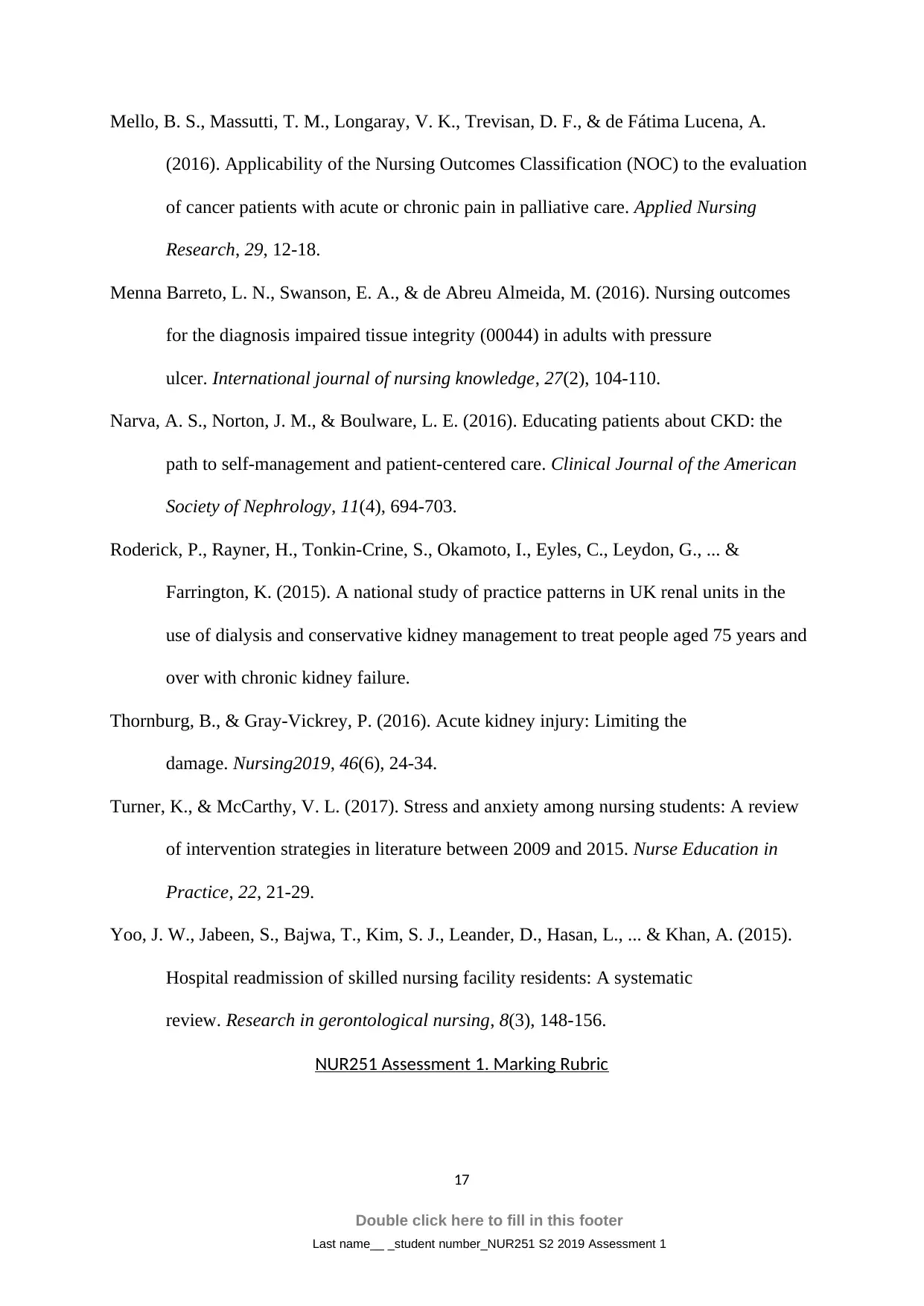
Mello, B. S., Massutti, T. M., Longaray, V. K., Trevisan, D. F., & de Fátima Lucena, A.
(2016). Applicability of the Nursing Outcomes Classification (NOC) to the evaluation
of cancer patients with acute or chronic pain in palliative care. Applied Nursing
Research, 29, 12-18.
Menna Barreto, L. N., Swanson, E. A., & de Abreu Almeida, M. (2016). Nursing outcomes
for the diagnosis impaired tissue integrity (00044) in adults with pressure
ulcer. International journal of nursing knowledge, 27(2), 104-110.
Narva, A. S., Norton, J. M., & Boulware, L. E. (2016). Educating patients about CKD: the
path to self-management and patient-centered care. Clinical Journal of the American
Society of Nephrology, 11(4), 694-703.
Roderick, P., Rayner, H., Tonkin-Crine, S., Okamoto, I., Eyles, C., Leydon, G., ... &
Farrington, K. (2015). A national study of practice patterns in UK renal units in the
use of dialysis and conservative kidney management to treat people aged 75 years and
over with chronic kidney failure.
Thornburg, B., & Gray-Vickrey, P. (2016). Acute kidney injury: Limiting the
damage. Nursing2019, 46(6), 24-34.
Turner, K., & McCarthy, V. L. (2017). Stress and anxiety among nursing students: A review
of intervention strategies in literature between 2009 and 2015. Nurse Education in
Practice, 22, 21-29.
Yoo, J. W., Jabeen, S., Bajwa, T., Kim, S. J., Leander, D., Hasan, L., ... & Khan, A. (2015).
Hospital readmission of skilled nursing facility residents: A systematic
review. Research in gerontological nursing, 8(3), 148-156.
NUR251 Assessment 1. Marking Rubric
17
Double click here to fill in this footer
Last name__ _student number_NUR251 S2 2019 Assessment 1
(2016). Applicability of the Nursing Outcomes Classification (NOC) to the evaluation
of cancer patients with acute or chronic pain in palliative care. Applied Nursing
Research, 29, 12-18.
Menna Barreto, L. N., Swanson, E. A., & de Abreu Almeida, M. (2016). Nursing outcomes
for the diagnosis impaired tissue integrity (00044) in adults with pressure
ulcer. International journal of nursing knowledge, 27(2), 104-110.
Narva, A. S., Norton, J. M., & Boulware, L. E. (2016). Educating patients about CKD: the
path to self-management and patient-centered care. Clinical Journal of the American
Society of Nephrology, 11(4), 694-703.
Roderick, P., Rayner, H., Tonkin-Crine, S., Okamoto, I., Eyles, C., Leydon, G., ... &
Farrington, K. (2015). A national study of practice patterns in UK renal units in the
use of dialysis and conservative kidney management to treat people aged 75 years and
over with chronic kidney failure.
Thornburg, B., & Gray-Vickrey, P. (2016). Acute kidney injury: Limiting the
damage. Nursing2019, 46(6), 24-34.
Turner, K., & McCarthy, V. L. (2017). Stress and anxiety among nursing students: A review
of intervention strategies in literature between 2009 and 2015. Nurse Education in
Practice, 22, 21-29.
Yoo, J. W., Jabeen, S., Bajwa, T., Kim, S. J., Leander, D., Hasan, L., ... & Khan, A. (2015).
Hospital readmission of skilled nursing facility residents: A systematic
review. Research in gerontological nursing, 8(3), 148-156.
NUR251 Assessment 1. Marking Rubric
17
Double click here to fill in this footer
Last name__ _student number_NUR251 S2 2019 Assessment 1
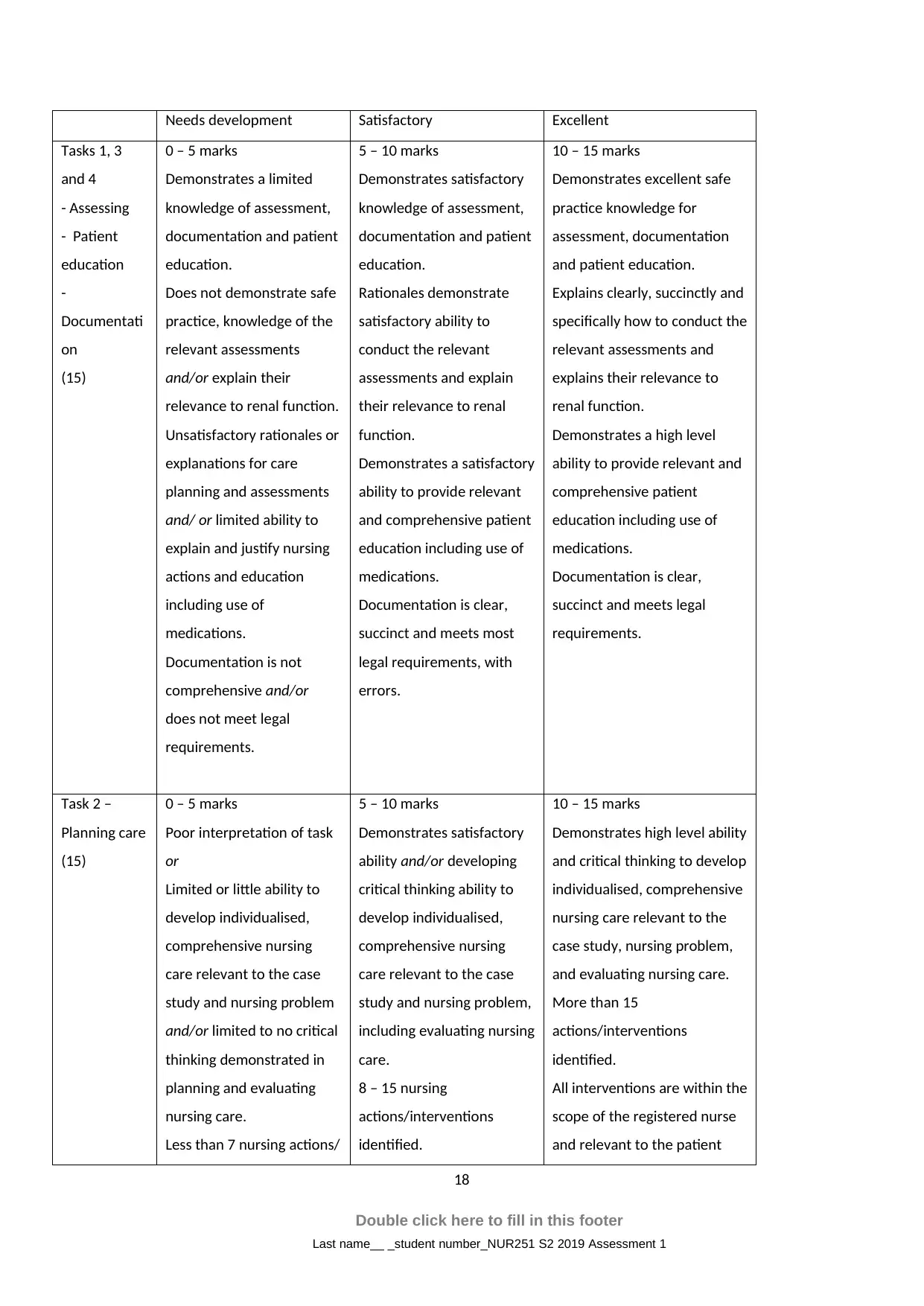
Needs development Satisfactory Excellent
Tasks 1, 3
and 4
- Assessing
- Patient
education
-
Documentati
on
(15)
0 – 5 marks
Demonstrates a limited
knowledge of assessment,
documentation and patient
education.
Does not demonstrate safe
practice, knowledge of the
relevant assessments
and/or explain their
relevance to renal function.
Unsatisfactory rationales or
explanations for care
planning and assessments
and/ or limited ability to
explain and justify nursing
actions and education
including use of
medications.
Documentation is not
comprehensive and/or
does not meet legal
requirements.
5 – 10 marks
Demonstrates satisfactory
knowledge of assessment,
documentation and patient
education.
Rationales demonstrate
satisfactory ability to
conduct the relevant
assessments and explain
their relevance to renal
function.
Demonstrates a satisfactory
ability to provide relevant
and comprehensive patient
education including use of
medications.
Documentation is clear,
succinct and meets most
legal requirements, with
errors.
10 – 15 marks
Demonstrates excellent safe
practice knowledge for
assessment, documentation
and patient education.
Explains clearly, succinctly and
specifically how to conduct the
relevant assessments and
explains their relevance to
renal function.
Demonstrates a high level
ability to provide relevant and
comprehensive patient
education including use of
medications.
Documentation is clear,
succinct and meets legal
requirements.
Task 2 –
Planning care
(15)
0 – 5 marks
Poor interpretation of task
or
Limited or little ability to
develop individualised,
comprehensive nursing
care relevant to the case
study and nursing problem
and/or limited to no critical
thinking demonstrated in
planning and evaluating
nursing care.
Less than 7 nursing actions/
5 – 10 marks
Demonstrates satisfactory
ability and/or developing
critical thinking ability to
develop individualised,
comprehensive nursing
care relevant to the case
study and nursing problem,
including evaluating nursing
care.
8 – 15 nursing
actions/interventions
identified.
10 – 15 marks
Demonstrates high level ability
and critical thinking to develop
individualised, comprehensive
nursing care relevant to the
case study, nursing problem,
and evaluating nursing care.
More than 15
actions/interventions
identified.
All interventions are within the
scope of the registered nurse
and relevant to the patient
18
Double click here to fill in this footer
Last name__ _student number_NUR251 S2 2019 Assessment 1
Tasks 1, 3
and 4
- Assessing
- Patient
education
-
Documentati
on
(15)
0 – 5 marks
Demonstrates a limited
knowledge of assessment,
documentation and patient
education.
Does not demonstrate safe
practice, knowledge of the
relevant assessments
and/or explain their
relevance to renal function.
Unsatisfactory rationales or
explanations for care
planning and assessments
and/ or limited ability to
explain and justify nursing
actions and education
including use of
medications.
Documentation is not
comprehensive and/or
does not meet legal
requirements.
5 – 10 marks
Demonstrates satisfactory
knowledge of assessment,
documentation and patient
education.
Rationales demonstrate
satisfactory ability to
conduct the relevant
assessments and explain
their relevance to renal
function.
Demonstrates a satisfactory
ability to provide relevant
and comprehensive patient
education including use of
medications.
Documentation is clear,
succinct and meets most
legal requirements, with
errors.
10 – 15 marks
Demonstrates excellent safe
practice knowledge for
assessment, documentation
and patient education.
Explains clearly, succinctly and
specifically how to conduct the
relevant assessments and
explains their relevance to
renal function.
Demonstrates a high level
ability to provide relevant and
comprehensive patient
education including use of
medications.
Documentation is clear,
succinct and meets legal
requirements.
Task 2 –
Planning care
(15)
0 – 5 marks
Poor interpretation of task
or
Limited or little ability to
develop individualised,
comprehensive nursing
care relevant to the case
study and nursing problem
and/or limited to no critical
thinking demonstrated in
planning and evaluating
nursing care.
Less than 7 nursing actions/
5 – 10 marks
Demonstrates satisfactory
ability and/or developing
critical thinking ability to
develop individualised,
comprehensive nursing
care relevant to the case
study and nursing problem,
including evaluating nursing
care.
8 – 15 nursing
actions/interventions
identified.
10 – 15 marks
Demonstrates high level ability
and critical thinking to develop
individualised, comprehensive
nursing care relevant to the
case study, nursing problem,
and evaluating nursing care.
More than 15
actions/interventions
identified.
All interventions are within the
scope of the registered nurse
and relevant to the patient
18
Double click here to fill in this footer
Last name__ _student number_NUR251 S2 2019 Assessment 1
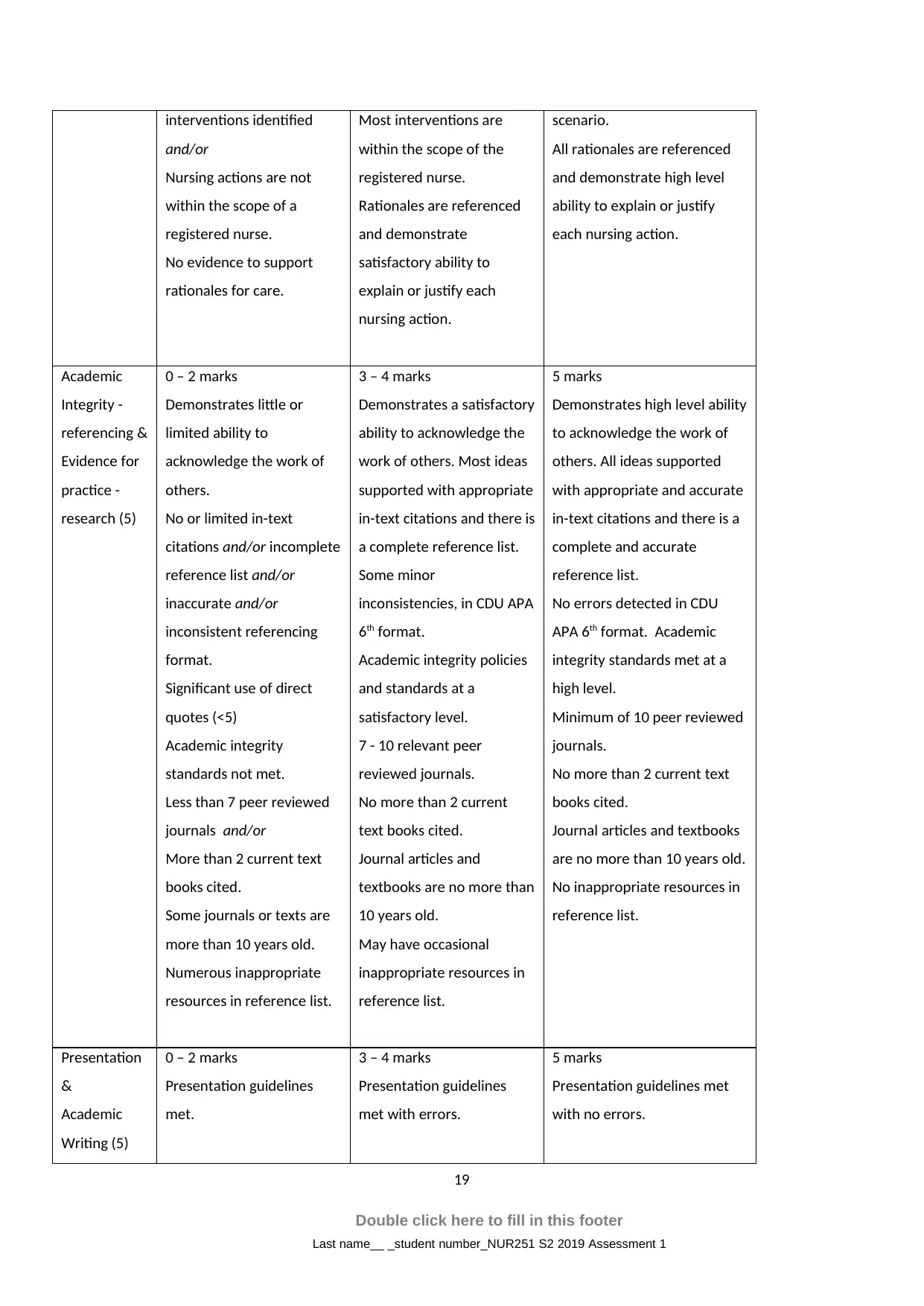
interventions identified
and/or
Nursing actions are not
within the scope of a
registered nurse.
No evidence to support
rationales for care.
Most interventions are
within the scope of the
registered nurse.
Rationales are referenced
and demonstrate
satisfactory ability to
explain or justify each
nursing action.
scenario.
All rationales are referenced
and demonstrate high level
ability to explain or justify
each nursing action.
Academic
Integrity -
referencing &
Evidence for
practice -
research (5)
0 – 2 marks
Demonstrates little or
limited ability to
acknowledge the work of
others.
No or limited in-text
citations and/or incomplete
reference list and/or
inaccurate and/or
inconsistent referencing
format.
Significant use of direct
quotes (<5)
Academic integrity
standards not met.
Less than 7 peer reviewed
journals and/or
More than 2 current text
books cited.
Some journals or texts are
more than 10 years old.
Numerous inappropriate
resources in reference list.
3 – 4 marks
Demonstrates a satisfactory
ability to acknowledge the
work of others. Most ideas
supported with appropriate
in-text citations and there is
a complete reference list.
Some minor
inconsistencies, in CDU APA
6th format.
Academic integrity policies
and standards at a
satisfactory level.
7 - 10 relevant peer
reviewed journals.
No more than 2 current
text books cited.
Journal articles and
textbooks are no more than
10 years old.
May have occasional
inappropriate resources in
reference list.
5 marks
Demonstrates high level ability
to acknowledge the work of
others. All ideas supported
with appropriate and accurate
in-text citations and there is a
complete and accurate
reference list.
No errors detected in CDU
APA 6th format. Academic
integrity standards met at a
high level.
Minimum of 10 peer reviewed
journals.
No more than 2 current text
books cited.
Journal articles and textbooks
are no more than 10 years old.
No inappropriate resources in
reference list.
Presentation
&
Academic
Writing (5)
0 – 2 marks
Presentation guidelines
met.
3 – 4 marks
Presentation guidelines
met with errors.
5 marks
Presentation guidelines met
with no errors.
19
Double click here to fill in this footer
Last name__ _student number_NUR251 S2 2019 Assessment 1
and/or
Nursing actions are not
within the scope of a
registered nurse.
No evidence to support
rationales for care.
Most interventions are
within the scope of the
registered nurse.
Rationales are referenced
and demonstrate
satisfactory ability to
explain or justify each
nursing action.
scenario.
All rationales are referenced
and demonstrate high level
ability to explain or justify
each nursing action.
Academic
Integrity -
referencing &
Evidence for
practice -
research (5)
0 – 2 marks
Demonstrates little or
limited ability to
acknowledge the work of
others.
No or limited in-text
citations and/or incomplete
reference list and/or
inaccurate and/or
inconsistent referencing
format.
Significant use of direct
quotes (<5)
Academic integrity
standards not met.
Less than 7 peer reviewed
journals and/or
More than 2 current text
books cited.
Some journals or texts are
more than 10 years old.
Numerous inappropriate
resources in reference list.
3 – 4 marks
Demonstrates a satisfactory
ability to acknowledge the
work of others. Most ideas
supported with appropriate
in-text citations and there is
a complete reference list.
Some minor
inconsistencies, in CDU APA
6th format.
Academic integrity policies
and standards at a
satisfactory level.
7 - 10 relevant peer
reviewed journals.
No more than 2 current
text books cited.
Journal articles and
textbooks are no more than
10 years old.
May have occasional
inappropriate resources in
reference list.
5 marks
Demonstrates high level ability
to acknowledge the work of
others. All ideas supported
with appropriate and accurate
in-text citations and there is a
complete and accurate
reference list.
No errors detected in CDU
APA 6th format. Academic
integrity standards met at a
high level.
Minimum of 10 peer reviewed
journals.
No more than 2 current text
books cited.
Journal articles and textbooks
are no more than 10 years old.
No inappropriate resources in
reference list.
Presentation
&
Academic
Writing (5)
0 – 2 marks
Presentation guidelines
met.
3 – 4 marks
Presentation guidelines
met with errors.
5 marks
Presentation guidelines met
with no errors.
19
Double click here to fill in this footer
Last name__ _student number_NUR251 S2 2019 Assessment 1
Paraphrase This Document
Need a fresh take? Get an instant paraphrase of this document with our AI Paraphraser

20
Double click here to fill in this footer
Last name__ _student number_NUR251 S2 2019 Assessment 1
Double click here to fill in this footer
Last name__ _student number_NUR251 S2 2019 Assessment 1
1 out of 20
Related Documents
Your All-in-One AI-Powered Toolkit for Academic Success.
+13062052269
info@desklib.com
Available 24*7 on WhatsApp / Email
![[object Object]](/_next/static/media/star-bottom.7253800d.svg)
Unlock your academic potential
© 2024 | Zucol Services PVT LTD | All rights reserved.




